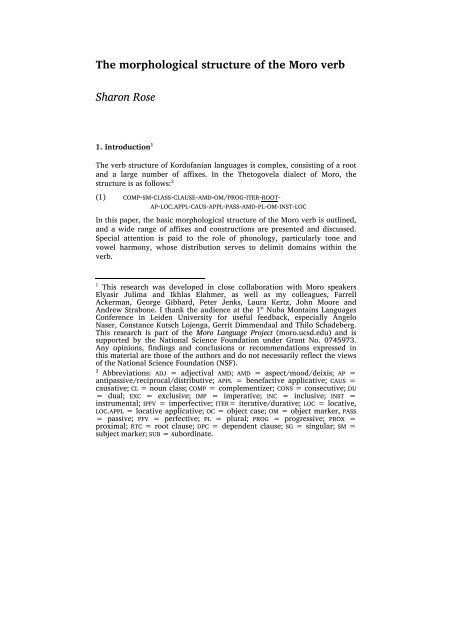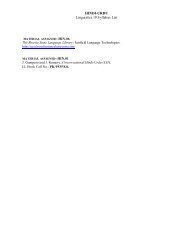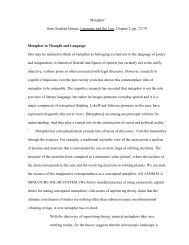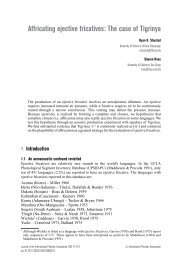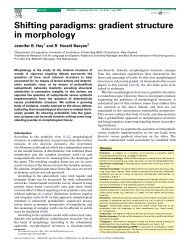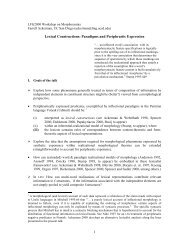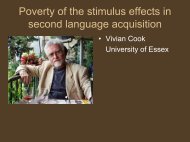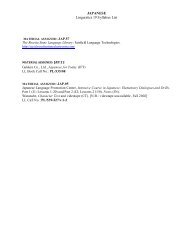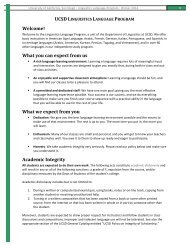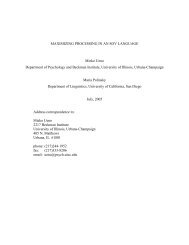The morphological structure of the Moro verb Sharon Rose
The morphological structure of the Moro verb Sharon Rose
The morphological structure of the Moro verb Sharon Rose
Create successful ePaper yourself
Turn your PDF publications into a flip-book with our unique Google optimized e-Paper software.
<strong>The</strong> <strong>morphological</strong> <strong>structure</strong> <strong>of</strong> <strong>the</strong> <strong>Moro</strong> <strong>verb</strong><br />
<strong>Sharon</strong> <strong>Rose</strong><br />
1. Introduction 1<br />
<strong>The</strong> <strong>verb</strong> <strong>structure</strong> <strong>of</strong> Kord<strong>of</strong>anian languages is complex, consisting <strong>of</strong> a root<br />
and a large number <strong>of</strong> affixes. In <strong>the</strong> <strong>The</strong>togovela dialect <strong>of</strong> <strong>Moro</strong>, <strong>the</strong><br />
<strong>structure</strong> is as follows: 2<br />
(1) COMP-SM-CLASS-CLAUSE-AMD-OM/PROG-ITER-ROOT-<br />
AP-LOC.APPL-CAUS-APPL-PASS-AMD-PL-OM-INST-LOC<br />
In this paper, <strong>the</strong> basic <strong>morphological</strong> <strong>structure</strong> <strong>of</strong> <strong>the</strong> <strong>Moro</strong> <strong>verb</strong> is outlined,<br />
and a wide range <strong>of</strong> affixes and constructions are presented and discussed.<br />
Special attention is paid to <strong>the</strong> role <strong>of</strong> phonology, particularly tone and<br />
vowel harmony, whose distribution serves to delimit domains within <strong>the</strong><br />
<strong>verb</strong>.<br />
1 This research was developed in close collaboration with <strong>Moro</strong> speakers<br />
Elyasir Julima and Ikhlas Elahmer, as well as my colleagues, Farrell<br />
Ackerman, George Gibbard, Peter Jenks, Laura Kertz, John Moore and<br />
Andrew Strabone. I thank <strong>the</strong> audience at <strong>the</strong> 1 st Nuba Montains Languages<br />
Conference in Leiden University for useful feedback, especially Angelo<br />
Naser, Constance Kutsch Lojenga, Gerrit Dimmendaal and Thilo Schadeberg.<br />
This research is part <strong>of</strong> <strong>the</strong> <strong>Moro</strong> Language Project (moro.ucsd.edu) and is<br />
supported by <strong>the</strong> National Science Foundation under Grant No. 0745973.<br />
Any opinions, findings and conclusions or recommendations expressed in<br />
this material are those <strong>of</strong> <strong>the</strong> authors and do not necessarily reflect <strong>the</strong> views<br />
<strong>of</strong> <strong>the</strong> National Science Foundation (NSF).<br />
2 Abbreviations: ADJ = adjectival AMD; AMD = aspect/mood/deixis; AP =<br />
antipassive/reciprocal/distributive; APPL = benefactive applicative; CAUS =<br />
causative; CL = noun class; COMP = complementizer; CONS = consecutive; DU<br />
= dual; EXC = exclusive; IMP = imperative; INC = inclusive; INST =<br />
instrumental; IPFV = imperfective; ITER= iterative/durative; LOC = locative,<br />
LOC.APPL = locative applicative; OC = object case; OM = object marker, PASS<br />
= passive; PFV = perfective; PL = plural; PROG = progressive; PROX =<br />
proximal; RTC = root clause; DPC = dependent clause; SG = singular; SM =<br />
subject marker; SUB = subordinate.
2<br />
<strong>Sharon</strong> <strong>Rose</strong><br />
<strong>Moro</strong> is classified as Western Heiban as part <strong>of</strong> <strong>the</strong> Kord<strong>of</strong>anian language<br />
family. Although some researchers have questioned <strong>the</strong> unity <strong>of</strong> Kord<strong>of</strong>anian<br />
(Blench, this volume), <strong>Moro</strong> is closely related to o<strong>the</strong>r Heiban languages, in<br />
particular, Tira. <strong>Moro</strong> is recognized as divided into seven different dialects,<br />
corresponding to tribal names. <strong>The</strong> particular dialect under study in this<br />
paper is <strong>The</strong>togovela, spoken in <strong>the</strong> area nor<strong>the</strong>ast <strong>of</strong> <strong>the</strong> main town <strong>of</strong> Umm<br />
Dorein. This is <strong>the</strong> dialect identified as Umm Gabralla (Toberelda) in<br />
Ethnologue (Lewis 2009) and as Tobəɽelda in Blench (2005). Two <strong>Moro</strong><br />
speakers, Elyasir Julima and Ikhlas Elahmer, provided <strong>the</strong> data presented in<br />
this paper, from <strong>the</strong> villages <strong>of</strong> Karakaray and Ikurchi, respectively.<br />
2. Aspect/mood/deixis forms and melodic tone patterns<br />
<strong>The</strong> <strong>verb</strong> root can never appear alone, but must combine minimally with an<br />
aspect/mood/spatial deixis (AMD) suffix. In this section, we examine four<br />
such AMD constructions, each <strong>of</strong> which has a different tonal pattern, which<br />
we term melodic tone. Most <strong>Moro</strong> <strong>verb</strong> roots take <strong>the</strong> shape (C)VC and<br />
(C)VCVC, although <strong>the</strong> first vowel may be a diphthong and <strong>the</strong> first or<br />
second consonant may be geminate or be expanded to a consonant cluster<br />
(CC). <strong>The</strong>re are also short roots consisting <strong>of</strong> only a consonant, which is<br />
usually geminated, and <strong>the</strong>re are some longer roots, which appear to have<br />
incorporated lexicalized extension suffixes.<br />
2.1 Imperative<br />
<strong>The</strong>togovela <strong>Moro</strong> has two kinds <strong>of</strong> imperatives, <strong>the</strong> proximal/itive<br />
imperative and <strong>the</strong> distal/ventive imperative, distinguished by both tone and<br />
a final suffix. <strong>The</strong> proximal imperative is used for actions that are near to <strong>the</strong><br />
speaker, or indicate motion away from <strong>the</strong> speaker. <strong>The</strong> distal/ventive is<br />
used for actions that are far away from <strong>the</strong> speaker or indicate motion<br />
towards <strong>the</strong> speaker. It can also be used to indicate emotional distance or<br />
lack <strong>of</strong> involvement in <strong>the</strong> action. We will use <strong>the</strong> terms ‘proximal’ and<br />
‘distal’ to refer to <strong>the</strong>se forms. <strong>The</strong> proximal form is <strong>the</strong> default form; it is<br />
more common, and is <strong>the</strong> form used when location or motion is unexpressed.<br />
This type <strong>of</strong> distinction is also found in <strong>the</strong> imperfective, and in some<br />
subordinate constructions in <strong>Moro</strong>. Verbal spatial deixis categories are also<br />
found in o<strong>the</strong>r Kord<strong>of</strong>anian languages such as Koalib (Quint 2006, 2009)<br />
where it is labeled centripetal/centrifugal, as well as Nilo-Saharan<br />
languages, particularly Nilotic languages (Dimmendaal 2003).
<strong>The</strong> <strong>morphological</strong> <strong>structure</strong> <strong>of</strong> <strong>the</strong> <strong>Moro</strong> <strong>verb</strong><br />
<strong>The</strong> proximal imperative is formed from <strong>the</strong> <strong>verb</strong> root and a final suffix -ó.<br />
All tone-bearing units in <strong>the</strong> proximal imperative <strong>verb</strong> stem bear high tone,<br />
which is marked with an acute accent (´). Low tone is unmarked. <strong>Moro</strong> has a<br />
two tone system, High (H) and Low (L). Jenks & <strong>Rose</strong> (2011) analyze it as a<br />
H vs. Ø system, where Ø is unmarked.<br />
(2) a. və́léð-ó pull! h. ábə́ɾ-ó fly!<br />
b. tə́ŋát ̪-ó lick! i. ódə́ɲ-ó squat!<br />
c. pə́ɡə́ð-ó pay! j. ámádát ̪-ó help!<br />
d. ʧómbə́ð-ó tickle! k. érl-ó walk!<br />
e. váð-ó shave! l. áɾ-ó cry!<br />
f. ɡə́ɲ-ó kill! m. áfː-ó build, shoot!<br />
g. lánd̪-ó close! n. óg-ó thresh!<br />
Verb roots with high vowels i ʌ u and some ə, cause <strong>the</strong> final suffix -ó to be<br />
realized as raised ú. This is part <strong>of</strong> <strong>the</strong> general vowel harmony system in<br />
<strong>Moro</strong>, whereby <strong>the</strong> higher vowels i ʌ u trigger raising <strong>of</strong> <strong>the</strong> lower vowels e a<br />
o to i ʌ u. <strong>The</strong> vowel ə participates in both types <strong>of</strong> harmony patterns, as seen<br />
by a comparison <strong>of</strong> (2c) and (3b).<br />
(3) a. mə́ɲʌ́ʧ-ú peel, remove layer! h. ʌ́wút ̪-ú throw!<br />
b. rə́gəń-ú work! i. ílíð-ú buy!<br />
c. wúndə́t ̪-ú wring! j. ʌ́ŋʌ́ʧ-ú show!<br />
d. sʌ́ð-ú defecate! k. ʌńdúð-ú bite!<br />
e. kíð-ú open! l. úrtə́ð-ú pull out!<br />
f. t̪únd̪-ú cough! m. íð-ú make!<br />
g. də́ɾ-ú wrap, cover! n. ʌ́ɡ-ú put!<br />
<strong>The</strong> distal imperative is formed from <strong>the</strong> <strong>verb</strong> root and <strong>the</strong> suffix -a. This<br />
vowel is raised to ʌ when attached to roots with high vowels. <strong>The</strong> entire <strong>verb</strong><br />
form is low-toned 3 .<br />
(4) a. vəleð-a pull! i. abəɾ w -a fly!<br />
b. pəɡəð-a pay! j. amadat ̪-a help!<br />
c. vað-a shave! k. aɾ-a cry!<br />
d. ɡəɲ-a kill! l. afː-a build, shoot!<br />
e. məɲʌʧ-ʌ peel, remove layer! m. ʌwut ̯-ʌ throw!<br />
f. rəgən-ʌ work! n. ilið-ʌ buy!<br />
g. sʌð-ʌ defecate! o. ʌnduð-ʌ bite!<br />
h. dəɾ-ʌ wrap, cover! p. ʌɡ-ʌ put!<br />
3 When followed by a noun phrase, or an object marker, <strong>the</strong> final suffix<br />
vowel carries high tone.<br />
3
4<br />
2.2 Perfective<br />
<strong>Sharon</strong> <strong>Rose</strong><br />
<strong>The</strong> perfective form <strong>of</strong> <strong>the</strong> <strong>verb</strong> also consists <strong>of</strong> <strong>the</strong> <strong>verb</strong> root and <strong>the</strong> suffix<br />
-ó (raised to [ú] by vowel harmony), but it is preceded by, at least, a root<br />
clause marker and a noun class concord marker. <strong>The</strong> following forms<br />
illustrate <strong>the</strong> 3SG perfective form <strong>of</strong> a number <strong>of</strong> different <strong>verb</strong> roots, marked<br />
with <strong>the</strong> default singular human class prefix g- (realized as k phrase-initially)<br />
and a finite clause marker a- in (5a-i). <strong>The</strong> class marker for 3 rd person<br />
changes depending on <strong>the</strong> noun class <strong>of</strong> <strong>the</strong> subject (see Gibbard et al. 2009<br />
for a discussion <strong>of</strong> <strong>The</strong>togovela <strong>Moro</strong> noun classes). <strong>The</strong> a- does not appear<br />
with <strong>the</strong> vowel-initial roots in (5j-r) due to vowel hiatus resolution which<br />
deletes <strong>the</strong> first in a sequence <strong>of</strong> two vowels.<br />
(5) a. g-a-doɡat ̪-ó fix j. g-udʌð-ú milk<br />
b. g-a-vəleð-ó pull k. g-abatʃ-ó lift<br />
c. g-ʌ-məɲʌʧ-ú peel l. g-ond̪ət ̪-ó dry (intr.)<br />
d. g-a-lalːəɲ-ó run m. g-afː-ó build, shoot<br />
e. g-a-vədað-ó sweep n. g-aləŋ-ó sing<br />
f. g-a-morʧ-ó take from o. g-id-ú fall down<br />
g. g-ʌ-t̪und̪-ú cough p. g-uɾ-ú blow (intr.)<br />
h. g-a-wað-ó poke q. g-al-ó slice<br />
i. g-a-sat ̪-ó chew r. g-a-mː-ó take<br />
<strong>The</strong> 3PL human class prefix is l-, e.g. l-a-dogat ̪-ó ‘<strong>the</strong>y fixed’. All 1 st and 2 nd<br />
persons have a fixed class marker g- like <strong>the</strong> forms in (5) do, but <strong>the</strong> g- is<br />
preceded by a subject marker, e.g. á-g-a-vəleð-ó ‘you (sg.) pulled’ or ɲá-g-avəleð-ó<br />
‘you (pl.) pulled’. See section 5.3 for a complete list. As for <strong>the</strong> tone<br />
pattern, <strong>the</strong> <strong>verb</strong> root is low-toned for all perfective <strong>verb</strong>s. <strong>The</strong> perfective<br />
does not have a distal/proximal distinction.<br />
2.3 Distal imperfective<br />
Like <strong>the</strong> imperative, <strong>the</strong> imperfective has two different spatial deixis<br />
distinctions. We will consider first <strong>the</strong> distal imperfective in this section,<br />
because it closely resembles <strong>the</strong> perfective in form, and <strong>the</strong> proximal<br />
imperfective has a more complicated tonal system, to be addressed in section<br />
3. <strong>The</strong> distal imperfective is identical to <strong>the</strong> perfective in terms <strong>of</strong> segmental<br />
make-up, but has an additional á- prefix with consonant-initial roots (6a-e)<br />
or, when this vowel is deleted, <strong>the</strong> H tone appears on <strong>the</strong> first vowel <strong>of</strong> <strong>the</strong><br />
root with vowel-initial roots (6f-j).
<strong>The</strong> <strong>morphological</strong> <strong>structure</strong> <strong>of</strong> <strong>the</strong> <strong>Moro</strong> <strong>verb</strong><br />
(6) a. g-á-doɡat ̪-ó fix f. g-údʌð-ú milk<br />
b. g-á-vəleð-ó pull g. g-ábatʃ-ó lift<br />
c. g-á-lalːəɲ-ó run h. g-á ↓ fː-ó build, shoot<br />
d. g-á-vədað-ó sweep i. g-áləŋ-ó sing<br />
e. g-á-wað-ó poke j. g-á ↓ l-ó slice<br />
We assume that this is a separate distal imperfective prefix á- ra<strong>the</strong>r than a<br />
high tone that appears on <strong>the</strong> finite root clause vowel a-. This is due to <strong>the</strong><br />
behavior <strong>of</strong> o<strong>the</strong>r clause markers. Relative clauses, clefts and some<br />
subordinate clauses are marked with é- or ə́- ra<strong>the</strong>r than <strong>the</strong> finite root clause<br />
marker a- 4 (see section 5.1), e.g. uʤí kévəleðó 5 ‘<strong>the</strong> man who pulled it’. <strong>The</strong><br />
exception to this pattern is with distal imperfectives: uʤí kávəleðó ‘<strong>the</strong> man<br />
who pulled it (over <strong>the</strong>re)’. We surmise that vowel hiatus between <strong>the</strong> clause<br />
prefix and <strong>the</strong> distal imperfective prefix results in loss <strong>of</strong> <strong>the</strong> second vowel,<br />
<strong>the</strong> clause prefix: k-é-á-vəleð-ó → kávəleðó. This is <strong>the</strong> same process that leads<br />
to <strong>the</strong> loss <strong>of</strong> <strong>the</strong> distal imperfective prefix (6f-j) adjacent to vowel-initial<br />
roots, as well as <strong>the</strong> clause vowel in (5j-r).<br />
<strong>The</strong> four forms so far discussed all display different tone patterns depending<br />
on <strong>the</strong> aspect, mood or spatial deixis. We refer to this type <strong>of</strong> tone pattern as<br />
melodic tone, following similar terminology in <strong>the</strong> literature on Bantu<br />
languages (Odden 1989, Marlo 2007). <strong>The</strong> distinction between <strong>the</strong> proximal<br />
imperative and <strong>the</strong> perfective illustrates that while suffixes can be<br />
phonologically identical, <strong>the</strong> tone <strong>of</strong> <strong>the</strong> rest <strong>of</strong> <strong>the</strong> <strong>verb</strong> stem can differ.<br />
(7) ROOT+AFFIXES TONE MELODY<br />
Proximal imperative [ROOT-ó] [H-H]<br />
Distal imperative [ROOT-a] [L-L]<br />
Perfective g-a-[ROOT-ó] [L-H]<br />
Distal imperfective g-[á-ROOT-ó] [H-L-H]<br />
<strong>The</strong> hallmark <strong>of</strong> <strong>the</strong> melodic tone <strong>verb</strong>s is that no matter <strong>the</strong> nature <strong>of</strong> <strong>the</strong><br />
<strong>verb</strong> root—its length or syllable <strong>structure</strong>, <strong>the</strong> tone pattern <strong>of</strong> <strong>the</strong> basic <strong>verb</strong><br />
stem is <strong>the</strong> same. This is quite different from <strong>the</strong> next set <strong>of</strong> <strong>verb</strong> forms we<br />
will examine, in which tone patterns differ depending on <strong>the</strong> segmental and<br />
syllabic make-up <strong>of</strong> <strong>the</strong> <strong>verb</strong> root.<br />
4<br />
<strong>The</strong> absence <strong>of</strong> a- could be a co-occurrence restriction or could be due to<br />
vowel hiatus resolution if <strong>the</strong> prefixes are ordered a-é or a-ə́.<br />
5<br />
<strong>The</strong> prefix k- instead <strong>of</strong> g- indicates ‘strong concord’; see Jenks (this<br />
volume).<br />
5
6<br />
<strong>Sharon</strong> <strong>Rose</strong><br />
3. Aspect/mood/deixis forms and default tone<br />
<strong>The</strong> proximal imperfective has a final suffix -a and <strong>the</strong> same prefixes as<br />
found with <strong>the</strong> perfective. However, unlike <strong>the</strong> perfective and <strong>the</strong> distal<br />
imperfective, <strong>the</strong> tone patterns that appear on <strong>verb</strong> roots in <strong>the</strong> proximal<br />
imperfective are varied and complex. <strong>The</strong>se have been discussed and<br />
analyzed at length in Jenks & <strong>Rose</strong> (2009, 2011). Here we outline <strong>the</strong> basic<br />
forms.<br />
Verb roots <strong>of</strong> <strong>the</strong> shape CVCVC (long roots) have a HH pattern on <strong>the</strong> root.<br />
<strong>The</strong> final a may be raised to ʌ or iə with vowel harmony.<br />
(8) CVCVC roots with light syllables: HH-L<br />
a. g-a-t ̪ávə́ð-a spit k. g-ʌ-ɾə́gəń-iə work<br />
b. g-a-k w ə́ɾéð-a scratch l. g-ʌ-mə́ɲʌ́ʧ-ʌ peel<br />
c. g-a-lə́ŋét ̪-a know m. g-ʌ-mə́lʌ́ð-iə exchange,<br />
replace<br />
d. g-a-váɾə́ð-a rake n. g-ʌ-ɾə́mə́t ̪-iə be blind<br />
e. g-a-rə́mə́t ̪ʷ-a tend o. g-ʌ-ɾə́mʷúg-iə get drunk<br />
f. g-a-dóɡát ̪-a fix p. g-ʌ-tíðəń-iə slip<br />
g. g-a-və́léð-a pull q. g-a-pə́ɡə́ð-eə pay<br />
h. g-a-ɲə́t ̪ə́ð-a be emaciated, r. g-a-ŋə́rə́ð-eə break <strong>of</strong>f small<br />
waste away piece, tap lightly<br />
i. g-a-tə́ŋát ̪-a lick s. g-a-ʤə́pə́ð-eə be rotten<br />
j. g-a-lə́və́ʧ-a hide<br />
<strong>The</strong> choice <strong>of</strong> final -ʌ or -iə does not appear predictable. Some roots (8q-s)<br />
show a final low -eə suffix, so diphthongs may have ano<strong>the</strong>r source besides<br />
vowel harmony. <strong>The</strong> final consonant in all <strong>the</strong>se long <strong>verb</strong> roots is usually<br />
one <strong>of</strong> a small class: ð t ̪ ʧ n; <strong>the</strong>se are all consonants that appear in extension<br />
suffixes (section 6), so it is possible that <strong>the</strong>se final consonants represent<br />
lexicalized extension markers.<br />
<strong>The</strong>re is a small set <strong>of</strong> CVCVC roots with a single H tone on <strong>the</strong> first syllable<br />
only. <strong>The</strong>re are so few <strong>of</strong> <strong>the</strong>se forms that it is hard to make any<br />
generalizations. <strong>The</strong>se are exceptions to <strong>the</strong> more general HH pattern.<br />
(9) HL pattern<br />
a. g-ʌ-dʌ́dəð-ʌ hiccup b. g-a-və́dað-a sweep<br />
Short <strong>verb</strong>s <strong>of</strong> <strong>the</strong> shape CVC fall into two classes with respect to <strong>the</strong><br />
distribution <strong>of</strong> H tone. While all <strong>verb</strong>s <strong>of</strong> this shape have H on <strong>the</strong> root<br />
vowel, H extends onto <strong>the</strong> final vowel for most <strong>verb</strong>s. This creates a lexical<br />
distinction between H-H and H-L melodies.
<strong>The</strong> <strong>morphological</strong> <strong>structure</strong> <strong>of</strong> <strong>the</strong> <strong>Moro</strong> <strong>verb</strong><br />
(10) H-H pattern H-L pattern<br />
a. g-ʌ-sʌ́ð-ʌ́ defecate f. g-a-tóð-a move<br />
b. g-a-wáð-á poke g. g-a-váð-a shave<br />
c. g-a-nát ̪-á taste h. g-a-sát ̪-a chew<br />
d. g-a-ɾát ̪-á clear land after harvest i. g-a-rát ̪-eə kneel<br />
e. g-a-boáɲ-á like, want j. g-a-noán-a watch<br />
Ano<strong>the</strong>r group <strong>of</strong> consonant initial <strong>verb</strong>s begins with a closed syllable, closed<br />
by a nasal, an r or a geminate consonant. In <strong>the</strong>se cases, H tone is restricted<br />
to <strong>the</strong> closed syllable and does not extend beyond it to <strong>the</strong> following syllable.<br />
<strong>The</strong>re are no exceptions to this pattern that we have found.<br />
(11) HL pattern with CVCCVC or H-L pattern with CVCC roots<br />
a. g-a-mʷándəð-eə ask g. g-a-wárð-a write<br />
b. g-a-wəńdat ̪-a see h. g-a-várt ̪-a lead, be in front <strong>of</strong><br />
c. g-ʌ-vəńdəɲ-a snap, break i. g-a-lánd̪-a close<br />
d. g-a-lálːəɲ-a run j. g-ʌ-t̪únd̪-ʌ cough<br />
e. g-ʌ-lʌ́lːʌð-iə scatter k. g-a-mórʧ-a take from<br />
f. g-a-ʧómbəð-a tickle l. g-a-kárm-a find guilty and fine<br />
Finally, <strong>the</strong>re is a group <strong>of</strong> consonant-only <strong>verb</strong> roots. As <strong>the</strong>re is no root<br />
vowel that can bear H tone, <strong>the</strong>se are all low-toned forms.<br />
(12) C-only roots – no H tone<br />
̪<br />
a. g-a-mː-a take d. g-ʌ-pʷː-ʌ beat<br />
b. g-a-rː-a kick (once), pound, stab e. g-ʌ-tː-iə drink<br />
c. g-a-sː-a eat<br />
Vowel-initial roots show a different tone pattern from <strong>the</strong> consonant-initial<br />
roots. Most vowel-initial roots with two vowels have a H tone only on <strong>the</strong><br />
second vowel. This H tone does not extend to a following suffix.<br />
(13) LH pattern – V-initial <strong>verb</strong> roots<br />
a. g-oɡə́t-a jump d. g-abə́t ̪ʷ-a climb<br />
b. g-obə́ð-a run away e. g-udʌ́ð-ʌ milk<br />
c. g-ʌwút ̪-ʌ drop f. g-abátʃ-a lift<br />
Recall that <strong>the</strong> clause marker a-, which marks finite clauses and normally<br />
precedes <strong>the</strong> root, is deleted by a regular hiatus process in which <strong>the</strong> first <strong>of</strong><br />
two adjacent vowels deletes.<br />
Vowel-initial roots that are <strong>of</strong> <strong>the</strong> shape VC have no H tone:<br />
7
8<br />
<strong>Sharon</strong> <strong>Rose</strong><br />
(14) L-L pattern – VC roots<br />
a. g-al-a slice c. g-uɾ-ʌ blow (intr.)<br />
b. g-oað-a mill, grind d. g-oar-a badmouth<br />
If <strong>the</strong> initial syllable is closed, however, H tone does appear on <strong>the</strong> initial<br />
syllable:<br />
(15) H-L pattern with VCC and HL pattern with VCCVC roots<br />
a. g-ʌńd-iə catch<br />
b. g-áfː-a build, shoot<br />
c. g-ónd̪ət ̪-a dry (int.)<br />
Finally, <strong>the</strong>re are a few VC and VCVC roots that show a single H tone on an<br />
initial vowel only; some (16d,e) are borrowings from Arabic:<br />
(16) H-L and HL exceptional pattern with VC or VCVC roots<br />
a. g-oás-a wash<br />
b. ŋ-ól-a drip (e.g. ŋáwá ŋóla ‘water drips’)<br />
c. g-ʌ́ŋəʧ-ʌ show<br />
d. g-ákəm-a judge<br />
e. g-álab-a play<br />
<strong>The</strong> patterns for tone distribution on <strong>the</strong> roots <strong>of</strong> proximal imperfective<br />
<strong>verb</strong>s are as follows. Less common forms are in paren<strong>the</strong>ses.<br />
(17) H tone melodies on proximal imperfective <strong>verb</strong>s<br />
Type <strong>of</strong> root Long Short<br />
Light syllables C-initial HH-L H-H<br />
(HL-L) (H-L)<br />
V-initial LH-L L-L<br />
(HL-L) (H-L)<br />
Heavy syllables C- or V-initial HL-L H-L<br />
<strong>The</strong> tone patterns are <strong>the</strong>refore largely predictable in <strong>the</strong> proximal<br />
imperfective, being dependent on <strong>the</strong> syllable <strong>structure</strong> <strong>of</strong> <strong>the</strong> root (Jenks &<br />
<strong>Rose</strong> 2009, 2011). <strong>The</strong> <strong>verb</strong> root has a H tone on <strong>the</strong> first vowel <strong>of</strong> <strong>the</strong> <strong>verb</strong><br />
root, unless <strong>the</strong> root is vowel-initial. This H tone never extends onto a<br />
second syllable if <strong>the</strong> first syllable is closed, but usually extends onto a<br />
second syllable if <strong>the</strong> first syllable is open. <strong>The</strong>re are some exceptions to this<br />
pattern, but all involve a H tone on <strong>the</strong> first vowel that does not extend. <strong>The</strong><br />
only forms that do not have H tone are short Cː or VC roots. As a result <strong>of</strong><br />
this largely predictable distribution, we refer to <strong>the</strong> tone pattern on proximal<br />
imperfective <strong>verb</strong>s as default tone. Since <strong>the</strong> general pattern is for <strong>verb</strong> roots
<strong>The</strong> <strong>morphological</strong> <strong>structure</strong> <strong>of</strong> <strong>the</strong> <strong>Moro</strong> <strong>verb</strong><br />
to have H tone and to locate it preferentially at <strong>the</strong> left edge, Jenks & <strong>Rose</strong><br />
(2011) argue that <strong>the</strong> H tone is inserted, as in certain Bantu languages with<br />
predictable tone systems (Odden 1989). <strong>The</strong> lexical dimension <strong>of</strong> <strong>the</strong> system<br />
concerns not <strong>the</strong> appearance <strong>of</strong> H tone, but its ability ei<strong>the</strong>r to extend, or to<br />
appear on a root-initial vowel.<br />
In addition to <strong>the</strong> proximal imperfective, a number <strong>of</strong> o<strong>the</strong>r <strong>verb</strong> forms also<br />
employ default tone. <strong>The</strong>se all appear in subordinate <strong>verb</strong> forms, which are<br />
marked by different prefixes than <strong>the</strong> imperfective and perfective forms<br />
discussed above. This sample shows <strong>the</strong> roots ʧombəð (HL pattern) ‘tickle’<br />
and ilið (LH pattern) ‘buy’ in 3SG. Unlike <strong>the</strong> proximal imperfective, <strong>the</strong>re is<br />
no clause marker or class marker. Instead, an invariant subject marker<br />
appears (3SG is áŋ-/ʌ́ŋ- or ə́ŋə́-) which may be preceded by a complementizer<br />
nə́-, nə- or t ̪ə́-. <strong>The</strong> proximal/distal distinctions in <strong>the</strong>se <strong>verb</strong> forms is <strong>the</strong><br />
same as with <strong>the</strong> main imperfectives and imperatives, but <strong>the</strong> distinction is<br />
conveyed only through <strong>the</strong> final suffix, not tone patterns.<br />
(18) ‘tickle’ ‘buy’<br />
subordinate 1 proximal (n)-áŋ- ↓ ʧómbəð-e (n)-ʌ́ŋ-ilíð-i<br />
subordinate 1 distal (n)-áŋ- ↓ ʧómbəð-a (n)-ʌ́ŋ-ilíð-ʌ<br />
subordinate 2 proximal (n)-áŋ- ↓ ʧómbəð-a (n)-ʌ́ŋ-ilíð-ʌ<br />
subordinate 2 distal (n)-áŋ- ↓ ʧómbəð-ó (n)-ʌ́ŋ-ilí ↓ ð-ú<br />
consecutive imperfective t̪-áŋ- ↓ ʧómbəð-ó t̪-ʌ́ŋ-ilí ↓ ð-ú<br />
consecutive proximal perfective n-ə́ŋə́- ↓ ʧómbəð-e n-ə́ŋ-ilíð-i<br />
consecutive distal perfective n-ə́ŋə́- ↓ ʧómbəð-a n-ə́ŋ-ilíð-ʌ<br />
negative g-anːá áŋ- ↓ ʧómbəð-a g-anːá ʌ́ŋ-ilíð-ʌ<br />
negative imperative ánːá á- ↓ ʧómbəð-a ánːá í ↓ líð-ʌ<br />
Subordinate 1 <strong>verb</strong>s are used in future constructions following <strong>the</strong> <strong>verb</strong>s ið<br />
‘make, do’ or vəl/vəd ‘go’, and as complements <strong>of</strong> certain <strong>verb</strong>s such as boaɲ<br />
‘want’. <strong>The</strong>y are marked with -e in <strong>the</strong> proximal, but with -a if a distal form<br />
is possible:<br />
(19) óráŋ g-a-və́l-á áŋ- ↓ áp-e ŋeɾá<br />
man SM.CL-RTC-go-IPFV 3SG.SM-take-SUB1 child<br />
<strong>the</strong> man is going to hold <strong>the</strong> child<br />
Subordinate 2 <strong>verb</strong>s occur as complements <strong>of</strong> <strong>the</strong> <strong>verb</strong>s indəʧin ‘try’ and neð<br />
‘refuse’. <strong>The</strong> distal form ends in ó, but o<strong>the</strong>rwise has <strong>the</strong> same tone pattern. 6<br />
6 <strong>The</strong> exception to default tone in <strong>the</strong> subordinate forms are <strong>the</strong> 1PL.EXCL and<br />
<strong>the</strong> 3PL, which always have low toned roots.<br />
9
10<br />
<strong>Sharon</strong> <strong>Rose</strong><br />
(20) k-a-neð-ó (n)-áŋə́-sː-a<br />
SM.CL-RTC-refuse-PFV (COMP-)3SG.SM-eat-SUB2<br />
he refused to eat<br />
<strong>The</strong> consecutive forms are used when two actions occur one after <strong>the</strong> o<strong>the</strong>r<br />
or simultaneously in alternation. <strong>The</strong> suffixes are ei<strong>the</strong>r -e, -a or -ó, but all<br />
have <strong>the</strong> same tone pattern on <strong>the</strong> root. <strong>The</strong> consecutive imperfective suffix<br />
-ó is homophonous with <strong>the</strong> perfective suffix -ó and <strong>the</strong> proximal imperative<br />
suffix -ó, discussed above, but it does not co-occur with <strong>the</strong> same tone<br />
pattern. This can be seen by <strong>the</strong> following forms:<br />
(21) a. perfective g-a-vəleð-ó s/he pulled<br />
g-a-ʧombəð-ó s/he tickled<br />
b. proximal imperative və́léð-ó pull!<br />
ʧómbə́ð-ó tickle!<br />
c. consecutive imperfective gidú t ̪-áŋ- ↓ və́lé ↓ ð-ó s/he fell down<br />
and was pulling<br />
gidú t ̪-áŋ- ↓ ʧómbəð-ó s/he fell down<br />
and was tickling<br />
Crucially, even though <strong>the</strong> proximal imperative and <strong>the</strong> consecutive<br />
imperfective both have H tone on <strong>the</strong> root, <strong>the</strong> distribution <strong>of</strong> this H is not<br />
<strong>the</strong> same. <strong>The</strong> imperative is all H-toned, but <strong>the</strong> consecutive imperfective<br />
shows a downstep between <strong>the</strong> H tone on <strong>the</strong> root and <strong>the</strong> H tone <strong>of</strong> <strong>the</strong><br />
suffix. <strong>The</strong> same pattern is found with <strong>the</strong> distal subordinate 2. This indicates<br />
that <strong>the</strong>re are two separate autosegmental H tones in <strong>the</strong> consecutive<br />
imperfective ra<strong>the</strong>r than one that is associated to all tone-bearing units, as in<br />
<strong>the</strong> proximal imperative.<br />
<strong>The</strong> distinction between default tone and melodic tone is based on <strong>the</strong><br />
aspect/mood/deixis (AMD) form <strong>of</strong> <strong>the</strong> <strong>verb</strong>. Three affixes, -a, -e and -ó<br />
combine with different tone marking, and different types <strong>of</strong> subject marking,<br />
as summarized below, with <strong>the</strong> <strong>verb</strong> root ləvəʧ ‘hide’.<br />
(22) Aspect/Mood/Deixis<br />
COMP SUBJECT AMD TONE EXAMPLE<br />
perfective (SM-)CL- -ó melodic L g-a-ləvəʧ-ó<br />
distal imperfective (SM-)CL- á- -ó melodic L g-á-ləvəʧ-ó<br />
proximal imperative — -ó melodic H lə́və́ʧ-ó<br />
consecutive<br />
imperfective<br />
t ̪ə́- SM -ó default t̪-áŋ- ↓ lə́və́ ↓ ʧ-ó<br />
subordinate 2 distal (nə́-) SM -ó default (n)-áŋ- ↓ ʧómbəð-ó
<strong>The</strong> <strong>morphological</strong> <strong>structure</strong> <strong>of</strong> <strong>the</strong> <strong>Moro</strong> <strong>verb</strong><br />
proximal imperfective (SM-)CL- -a default g-a-lə́və́ʧ-a<br />
proximal imperative — -a melodic L ləvəʧ-a<br />
negative SM -a default g-anːá<br />
áŋ- ↓ lə́və́ʧ-a<br />
negative imperative SM -a default ánːá á- ↓ lə́və́ʧ-a<br />
subordinate 2<br />
proximal<br />
(nə́-) SM -a default (n)-áŋ- ↓ lə́və́ʧ-a<br />
subordinate 1 distal (nə́-) SM -a default (n)-áŋ- ↓ lə́və́ʧ-a<br />
consecutive distal<br />
perfective<br />
subordinate 1<br />
proximal<br />
consecutive proximal<br />
perfective<br />
nə- SM -a default n-ə́ŋə́- ↓ lə́və́ʧ-a<br />
(nə́-) SM -e default (n)-áŋ- ↓ lə́və́ʧ-e<br />
nə- SM -e default n-ə́ŋə́- ↓ lə́və́ʧ-e<br />
In conclusion, <strong>the</strong>re is a wide array <strong>of</strong> aspect/mood/deixis constructions<br />
consisting <strong>of</strong> an AMD suffix in combination with i) a particular subject<br />
marking paradigm and ii) default tone or a specific melodic tone pattern.<br />
Melodic tone patterns occur with imperatives, perfective and distal<br />
imperfective. Default tone patterns occur with most dependent <strong>verb</strong> forms as<br />
well as <strong>the</strong> proximal imperfective.<br />
4. Macrostem prefixes<br />
<strong>The</strong>re are several prefixes that precede <strong>the</strong> <strong>verb</strong> root. We propose that <strong>the</strong>y<br />
are divided into two groups, those that form part <strong>of</strong> a constituent we label<br />
<strong>the</strong> macrostem, demarcated by <strong>the</strong> left square bracket in (23) and those that<br />
precede it as part <strong>of</strong> a larger <strong>verb</strong> stem constituent. Evidence for this division<br />
is based on phonology.<br />
(23) COMP-SM-CLASS-CLAUSE-AMD- [OM/PROG-ITER-ROOT…<br />
[macrostem<br />
4.1 Progressive v-<br />
Many vowel-initial roots have an extra prefix v- that only appears in <strong>the</strong><br />
proximal imperfective. As reported in Jenks & <strong>Rose</strong> (2009), this prefix,<br />
which we label ‘progressive’ is restricted to appear i) only on vowel-initial<br />
roots and ii) only if <strong>the</strong> <strong>verb</strong> root contains no round vowel or labial<br />
11
12<br />
<strong>Sharon</strong> <strong>Rose</strong><br />
consonant. <strong>The</strong> v-prefix does not have a clear meaning in most cases,<br />
although its presence can sometimes distinguish <strong>the</strong> standard inceptive<br />
interpretation <strong>of</strong> <strong>the</strong> proximal imperfective from <strong>the</strong> progressive.<br />
(24) a. g-a-v-áj-á die e. g-ʌ-v-ə́líð-ʌ buy<br />
b. g-a-v-áɾ-á cry f. g-ʌ-v-ʌ́ɡə́r-iə read<br />
c. g-ʌ-v-ə́d-iə́ fall down g. g-a-v-álə́ŋ-a sing<br />
d. g-ʌ-v-ʌńd-iə catch h. g-a-v-əńdətʃin-iə try<br />
Some roots require <strong>the</strong> v-prefix, whereas for o<strong>the</strong>rs, it is optional: e.g. g-ʌ-vʌ́ɡ-iə́<br />
or g-ʌɡ-iə ‘s/he is about to put’. When <strong>the</strong> v-prefix appears, <strong>the</strong> <strong>verb</strong>s<br />
resemble consonant-initial roots in terms <strong>of</strong> tone distribution: H tone appears<br />
on <strong>the</strong> first vowel <strong>of</strong> <strong>the</strong> root, and can extend to <strong>the</strong> right if on a light<br />
syllable. Jenks & <strong>Rose</strong> (2009) argue that <strong>the</strong> v-prefix licenses <strong>the</strong> default H<br />
tone appearing on <strong>the</strong> first vowel <strong>of</strong> <strong>the</strong> root as it provides an initial<br />
consonant within <strong>the</strong> macrostem.<br />
4.2 Durative/iterative<br />
<strong>The</strong> durative/iterative prefix directly precedes <strong>the</strong> root, and conveys <strong>the</strong><br />
meaning <strong>of</strong> repeated action or sustained action. It is a reduplicative prefix<br />
and takes <strong>the</strong> shape Vkː- if it attaches to a vowel initial noun, where <strong>the</strong> V<br />
copies <strong>the</strong> first vowel <strong>of</strong> <strong>the</strong> root. Or, it takes <strong>the</strong> shape CaC- if it attaches to<br />
a consonant initial noun, where <strong>the</strong> C stands for copies <strong>of</strong> <strong>the</strong> first root<br />
consonant. 7 <strong>The</strong> addition <strong>of</strong> CaC- results in a geminate consonant with <strong>the</strong><br />
root-initial consonant (we transcribe <strong>the</strong> geminates as two consonants here<br />
to show morpheme boundaries). <strong>The</strong> forms shown here are in <strong>the</strong> proximal<br />
imperfective:<br />
(25) Durative/Iterative<br />
a. g-oɡə́t ̪-ə g-ókː-oɡət ̪-a jump<br />
b. g-ál-a g-ákː-al-a slice<br />
c. g-a-ðə́w-á g-a-ðáð-ðəw-a poke<br />
d. g-a-və́léð-a g-a-váf-fərleð-a pull<br />
e. g-a-t ̪ávə́ð-a g-a-d̪át ̪-t ̪avəð-a spit<br />
7 Ano<strong>the</strong>r method <strong>of</strong> marking <strong>the</strong> durative/iterative is through <strong>the</strong> infix -r-,<br />
which appears after <strong>the</strong> first vowel <strong>of</strong> <strong>the</strong> root. It can occur alone, typically<br />
with vowel-initial roots, or co-occur with <strong>the</strong> reduplicative prefix:<br />
ŋodóɾə́wa ŋidú <strong>the</strong> leaves fell ŋodóɾə́wa ŋirtú <strong>the</strong> leaves fell (rep.)<br />
gápa he is about to carry gárpa he is carrying<br />
ígilið-ú I bought it ígirliðú I bought (it) (rep.)
<strong>The</strong> <strong>morphological</strong> <strong>structure</strong> <strong>of</strong> <strong>the</strong> <strong>Moro</strong> <strong>verb</strong><br />
f. g-a-də́rn-a g-a-dát-tərn-a press<br />
g. g-a-k w ə́réð-a g-a-ɡák-k w əreð-a scratch<br />
h. g-a-bə́ɾ-á g-a-báp-pəɾ-a touch<br />
i. g-ʌ-p w ə́lː-iə g-ʌ-bʌ́p-p w ə́lː-iə hollow a hole<br />
Voiced geminate obstruents that result from <strong>the</strong> prefixation are devoiced<br />
(except for ðː). When <strong>the</strong> root-initial consonant is voiceless (25e,g,i),<br />
voiceless dissimilation occurs and <strong>the</strong> first consonant <strong>of</strong> <strong>the</strong> prefix becomes<br />
voiced. Voiceless dissimilation is widespread in <strong>Moro</strong> and prevents two<br />
voiceless consonants co-occurring across an intervening vowel (<strong>Rose</strong> 2011).<br />
<strong>The</strong> geminate devoicing and voiceless dissimilation mean that <strong>the</strong> form <strong>of</strong><br />
<strong>the</strong> prefix is always C [+voice]aC [-voice] regardless <strong>of</strong> <strong>the</strong> underlying voicing<br />
quality <strong>of</strong> <strong>the</strong> initial root. 8 <strong>The</strong> durative/iterative prefix is H toned in <strong>the</strong>se<br />
forms, but <strong>the</strong> root is not. This pattern is true not just for <strong>the</strong> proximal<br />
imperfective, but indeed all forms that have default tone. Also note that<br />
vowel harmony affects <strong>the</strong> durative prefix, raising <strong>the</strong> vowel from a to ʌ, as<br />
in (25i). Finally, <strong>the</strong> progressive v-prefix precedes <strong>the</strong> durative prefix: kʌ-vʌ́kː-ʌnd-iə<br />
‘he is holding (durative)’.<br />
Verb forms that have melodic tone apply <strong>the</strong> particular melodic tone pattern<br />
associated with that AMD form to <strong>the</strong> constituent consisting <strong>of</strong> root and<br />
prefix:<br />
(26) Perfective [L]-ó g-a-[bap-pəɾ]-ó he touched<br />
Distal imperfective á-[L]-ó g-á-[bap-pəɾ]-ó he is about to<br />
touch (<strong>the</strong>re)<br />
Proximal imperative [H]-ó [páp-pə́ɾ]-ó touch!<br />
Distal imperative [L]-a [pap-pəɾ]-a touch! (<strong>the</strong>re)<br />
To summarize, both <strong>the</strong> v-prefix and <strong>the</strong> durative/iterative interact with <strong>the</strong><br />
tone pattern applied to <strong>the</strong> <strong>verb</strong> stem. <strong>The</strong> v-prefix allows H tone to appear<br />
on vowel-initial roots in <strong>the</strong> proximal imperfective by serving as <strong>the</strong> initial<br />
consonant <strong>of</strong> <strong>the</strong> root. <strong>The</strong> durative/iterative adopts <strong>the</strong> tone pattern <strong>of</strong> <strong>the</strong><br />
root depending on <strong>the</strong> aspect/mood/deixis form. For default tone, it is<br />
consistently H-toned, and H tone fails to appear on <strong>the</strong> <strong>verb</strong> root. Jenks &<br />
<strong>Rose</strong> (2011) analyze this distribution as <strong>the</strong> macrostem requiring a H tone at<br />
<strong>the</strong> left edge. Since <strong>the</strong> durative/iterative prefix is a closed syllable, H tone<br />
does not extend onto <strong>the</strong> next syllable. No H tone is needed on <strong>the</strong> <strong>verb</strong> root.<br />
In o<strong>the</strong>r words, default tone appears on <strong>the</strong> durative/iterative prefix. For<br />
8 This is true except in <strong>the</strong> imperative, where <strong>the</strong> initial obstruent <strong>of</strong> <strong>the</strong><br />
durative/iterative is voiceless.<br />
13
14<br />
<strong>Sharon</strong> <strong>Rose</strong><br />
melodic tone <strong>verb</strong> forms, however, <strong>the</strong> durative/iterative prefix is ei<strong>the</strong>r H<br />
or L depending on <strong>the</strong> particular tone requirements <strong>of</strong> each tone melody.<br />
4.3 Object marker<br />
<strong>The</strong> next prefix to consider is <strong>the</strong> object marker. Object markers in <strong>Moro</strong> do<br />
not inflect for noun class, and cannot co-occur with an overt lexical object.<br />
As in related languages such as Tira and Otoro (Stevenson 1941/2009),<br />
object markers appear as ei<strong>the</strong>r prefixes or suffixes, depending on <strong>the</strong><br />
particular aspect/mood/deixis construction. Consider <strong>the</strong> contrast between<br />
<strong>the</strong> <strong>verb</strong> g-a-ŋá-ʧombəð-a ‘s/he is about to tickle you’ and g-a-ʧombəð-ə́-ŋá<br />
‘s/he tickled you’. <strong>The</strong> object marker ŋá is <strong>the</strong> same in both <strong>verb</strong> forms; only<br />
its position differs. Prefixal object markers occur with <strong>the</strong> proximal<br />
imperfective and all <strong>the</strong> subordinate <strong>verb</strong> forms outlined in section 3 — in<br />
o<strong>the</strong>r words, precisely those <strong>verb</strong> forms that are marked with default tone. A<br />
list <strong>of</strong> object markers for <strong>the</strong> proximal imperfective is given below 9 :<br />
(27) Proximal imperfective with objects<br />
1SG g-a-ɲə́-ʧombəð-a<br />
2SG g-a-ŋá-ʧombəð-a<br />
3SG g-a-ŋó-ʧombəð-a<br />
1DU.INC g-á-ńdə-ʧombəð-a<br />
1PL.INC g-á-ńdə-ʧombəð-a-r<br />
1PL.EXC g-a-ɲə́-ʧombəðá-lánda<br />
2PL g-á-ńdə-ʧombəð-a<br />
3PL g-a-ʧómbəð-a-lo<br />
When <strong>the</strong> object prefix appears before <strong>the</strong> root, <strong>the</strong> H tone that normally<br />
appears on <strong>the</strong> root (g-a-ʧómbəð-a ‘s/he is about to tickle’) is absent. <strong>The</strong> 3 rd<br />
plural is <strong>the</strong> exception to <strong>the</strong> prefix pattern. Its object marker consistently<br />
appears as a suffix in all <strong>verb</strong> forms, and <strong>the</strong> H tone appears on <strong>the</strong> <strong>verb</strong><br />
root.<br />
In two forms, <strong>the</strong> 1PL.EXC and <strong>the</strong> 1PL.INC, an additional suffix is also<br />
observed. <strong>The</strong> suffix -lánda distinguishes <strong>the</strong> 1SG object from <strong>the</strong> 1PL.EX<br />
object. <strong>The</strong> -r is a plural marker also used to distinguish 1PL.INC subject from<br />
1DU.INC subject, and to distinguish <strong>the</strong> 2SG from <strong>the</strong> 2PL imperative, see (28):<br />
9 It is not easy to tell if <strong>the</strong> 1PL.EXC is -álánda or -lánda. Data from <strong>the</strong><br />
position <strong>of</strong> <strong>the</strong> plural marker -r (section 6.1) suggests <strong>the</strong> later. Thanks to<br />
Angelo Naser for comments on this point.
<strong>The</strong> <strong>morphological</strong> <strong>structure</strong> <strong>of</strong> <strong>the</strong> <strong>Moro</strong> <strong>verb</strong><br />
(28) 1DU.INC álə́-ʧombəð-a we two are about to tickle<br />
1PL.INC álə́-ʧombəð-a-r we all are about to tickle<br />
2SG PROX.IMP ʧómbə́ð-ó tickle!<br />
2PL PROX.IMP ʧómbə́ð-ó-r tickle! (pl.)<br />
If <strong>the</strong>re is more than one object marker, only one can appear as a prefix, and<br />
<strong>the</strong> o<strong>the</strong>r must appear as a suffix. See <strong>Rose</strong> & Jenks (2011) for more details.<br />
<strong>The</strong> object prefixes appear before <strong>the</strong> durative/iterative prefix, and cannot<br />
co-occur with <strong>the</strong> progressive v-prefix. This latter restriction is<br />
morphophonological ra<strong>the</strong>r than semantic, as v- can co-occur with <strong>the</strong> 3PL -lo<br />
object marker: g-ʌ́-ɲ-ʌnd-iə ‘he is about to hold me’ versus g-ʌ-v-ʌńd-iə-lo ‘he is<br />
about to hold <strong>the</strong>m’. <strong>The</strong> H tone from <strong>the</strong> object prefix shifts to <strong>the</strong> previous<br />
vowel.<br />
<strong>The</strong> H tone which normally appears on <strong>the</strong> root or on <strong>the</strong> durative/iterative<br />
prefix is absent when an object prefix is present. <strong>Rose</strong> & Jenks (2011) argue<br />
that <strong>the</strong> H tone <strong>of</strong> <strong>the</strong> object marker functions as <strong>the</strong> default tone <strong>of</strong> <strong>the</strong> <strong>verb</strong><br />
stem, obviating <strong>the</strong> need to position a H tone on <strong>the</strong> <strong>verb</strong> root. Ano<strong>the</strong>r<br />
possible analysis is to treat this as a type <strong>of</strong> tone dissimilation effect, in<br />
which only a single H tone is allowed at <strong>the</strong> left edge <strong>of</strong> <strong>the</strong> macrostem.<br />
Finally, like <strong>the</strong> durative/iterative prefix, vowel harmony can affect <strong>the</strong><br />
object prefix: e.g. g-ʌ-ŋʌ́-dəɾ-iə ‘he is about to cover you’.<br />
To summarize, <strong>the</strong> durative/iterative prefix, <strong>the</strong> progressive prefix, and <strong>the</strong><br />
object marker all affect <strong>the</strong> distribution <strong>of</strong> default H tone. <strong>The</strong> leftmost<br />
element in <strong>the</strong> macrostem bears H tone, and <strong>the</strong> o<strong>the</strong>r elements do not. We<br />
now turn to <strong>the</strong> o<strong>the</strong>r prefixes in <strong>the</strong> <strong>verb</strong> stem, many <strong>of</strong> which have H tone<br />
that co-occurs with default H tone. We maintain that this constitutes<br />
evidence for <strong>the</strong> macrostem boundary.<br />
5. Verb stem prefixes<br />
<strong>The</strong> prefixes that occur to <strong>the</strong> left <strong>of</strong> <strong>the</strong> macrostem boundary are as<br />
follows 10 .<br />
10 It is possible that <strong>the</strong>re is also a tense prefix developing in <strong>the</strong> language.<br />
For example, <strong>the</strong> form á-gá-g-a-t ̪əŋat ̪-ó ‘you had licked it’ suggests a<br />
reduplicative prefix gá- with H tone that copies <strong>the</strong> elements to its right.<br />
However, this ‘prefix’ appears to be <strong>the</strong> fusion <strong>of</strong> <strong>the</strong> <strong>verb</strong> ‘to be’ with a<br />
following <strong>verb</strong> with <strong>the</strong> same subject, clause and aspect marking, giving <strong>the</strong><br />
appearance <strong>of</strong> reduplication: á-g-a(w)-ó á-g-a-t ̪əŋat ̪-ó → ágágat ̪əŋat ̪ó. <strong>The</strong>re is<br />
no vowel harmony between <strong>the</strong> two, an indication <strong>of</strong> separate words: né-n-i-<br />
15
16<br />
<strong>Sharon</strong> <strong>Rose</strong><br />
(29) COMP-SM-CLASS-CLAUSE-AMD-[OM/PROG-ITER-ROOT…<br />
Starting from <strong>the</strong> macrostem boundary, we have already discussed <strong>the</strong> distal<br />
imperfective prefix á- in section 2.3 that appears before <strong>the</strong> basic <strong>verb</strong> stem.<br />
Since it appears only with melodic tone, its effect on default tone cannot be<br />
determined, and we do not discuss it fur<strong>the</strong>r.<br />
5.1 Clause markers<br />
<strong>The</strong>re are three basic clause markers that <strong>Moro</strong> employs in a variety <strong>of</strong><br />
constructions: a-, é-, ə́-. <strong>The</strong>y all appear following <strong>the</strong> class marker and<br />
preceding <strong>the</strong> macrostem, and can be raised by vowel harmony.<br />
<strong>The</strong> finite root clause marker a- appears on <strong>the</strong> <strong>verb</strong> in basic main clause<br />
forms (30a-b) as well as in some subordinate clauses introduced by <strong>verb</strong>s<br />
such as ləŋet ̪ ‘know’ or at ̪ ‘say/think’ (30b). We gloss this vowel as ‘root<br />
clause’ (RTC):<br />
(30) a. umːiə g-a-land̪-ó ʌuɾí<br />
boy SM.CL-RTC-close-PFV door<br />
<strong>the</strong> boy closed <strong>the</strong> door<br />
b. mama g-a-v-át ̪-á umːiə g-a-ker-ó gəla<br />
mama SM.CL-RTC-PROG-think-IPFV boy SM.CL-RTC-broke-PFV plate<br />
Mama thinks <strong>the</strong> boy broke <strong>the</strong> plate<br />
<strong>The</strong> clause marker é- is used in some subordinate constructions that are<br />
complements <strong>of</strong> main <strong>verb</strong>s <strong>of</strong> perception such as nː ‘hear’ or wəndat ̪ ‘watch,<br />
see’ (31a), as well as in subject clefts, relative clauses and content cleft<br />
questions (31b). This é- does not co-occur with a complementizer. We gloss<br />
it here as Dependent Clause 1 (DC1).<br />
(31) a. ŋálːo g-a-wəndat ̪-ó kúku-ŋ g-é-mː-ó ówːá<br />
Ngalo SM.CL-RTC-watch-PFV Kuku-OC SM.CL-DPC1-take-PFV woman<br />
Ngalo watched Kuku marry <strong>the</strong> woman<br />
b. ŋwʌ́ʤʌ́kːi g-é-mː-ó ówːá k-oal-á<br />
who SM.CL-DPC1-take-PFV woman SM.CL-tall-ADJ<br />
Who married <strong>the</strong> tall woman?<br />
sʌtʃ-ú ‘that I had seen’ We <strong>the</strong>refore leave aside fur<strong>the</strong>r discussion <strong>of</strong> a<br />
possible tense prefix in this paper.
<strong>The</strong> <strong>morphological</strong> <strong>structure</strong> <strong>of</strong> <strong>the</strong> <strong>Moro</strong> <strong>verb</strong><br />
<strong>The</strong> clause marker ə́- appears in some subordinate constructions as <strong>the</strong><br />
complement <strong>of</strong> <strong>verb</strong>s such as mwandəð ‘ask’ and lugət ̪ ‘tell’ (32a) as well as<br />
with non-subject clefts, relative clauses, and content cleft questions (32b).<br />
We gloss it here as Dependent Clause 2 (DC2).<br />
(32) a. é-g-a-mʷandəð-ó-ŋó t ̪á g-ə́- ↓ náʧ-a-lo<br />
1SG.SM-CL-RTC-ask-PFV-3SG.OM COMP SM.CL-DPC2-give-IPFV-3PL.OM<br />
ut ̪əɾə<br />
pig<br />
I asked him to give <strong>the</strong>m a pig<br />
b. ŋwʌńdə́kːi (n-)úʤí (nə́-)g-ə́-wənd̪at ̪-ó<br />
CLEFT.what (COMP-)man (COMP-)SM.CL-DPC2-watch-PFV<br />
What did <strong>the</strong> man watch?<br />
<strong>The</strong> clause marker ə́- does not appear with 1 st and 2 nd persons. <strong>The</strong>se forms<br />
also lack <strong>the</strong> class marker g- which typically precedes <strong>the</strong> clause marker, so<br />
<strong>the</strong> main <strong>verb</strong> form is distinguished from <strong>the</strong> dependent clause by <strong>the</strong> lack <strong>of</strong><br />
<strong>the</strong>se markers. Compare <strong>the</strong> main form é-g-a-wəndat ̪-ó ‘I watched it’ with <strong>the</strong><br />
alternate clause form: ŋínə́-ŋːí é-wəndat ̪-ó ‘<strong>the</strong> dog that I watched’.<br />
With respect to tone interaction, <strong>the</strong> prefixes é- and ə́- co-occur with default<br />
tone <strong>of</strong> <strong>the</strong> macrostem. This is seen with example (33), in which <strong>the</strong> é-<br />
appears adjacent to <strong>the</strong> H tone at <strong>the</strong> left edge <strong>of</strong> <strong>the</strong> macrostem. In this<br />
example, <strong>the</strong> prefix triggers downstep on <strong>the</strong> <strong>verb</strong> root H tone in (33a) or <strong>the</strong><br />
durative H-toned prefix in (33b):<br />
(33) a. ŋeɾá ŋ-é- ↓ ðә́w-á <strong>the</strong> girl who is about to poke<br />
b. ŋeɾá ŋ-é- ↓ ðáð-ðәw-a <strong>the</strong> girl who is about to poke repetitively<br />
This type <strong>of</strong> tone interaction is markedly different from that between <strong>the</strong><br />
durative/iterative prefix and root tone within <strong>the</strong> macrostem. In that case,<br />
only one H tone can appear, and it appears on <strong>the</strong> leftmost element. <strong>The</strong> H<br />
tone <strong>of</strong> <strong>the</strong> clause marker, on <strong>the</strong> o<strong>the</strong>r hand, co-occurs with H tone on <strong>the</strong><br />
macrostem. Downstep is an indication <strong>of</strong> two separate H tones (Odden 1982)<br />
and <strong>the</strong> fact that it occurs only when <strong>the</strong>se particular affixes are juxtaposed,<br />
but not o<strong>the</strong>rs, indicates a boundary. We <strong>the</strong>refore conclude that downstep<br />
marks <strong>the</strong> left edge <strong>of</strong> <strong>the</strong> macrostem. 11<br />
11 We have no evidence to postulate a floating L tone to mark downstep, so<br />
we assume that two separate H tones across a boundary is sufficient.<br />
17
18<br />
<strong>Sharon</strong> <strong>Rose</strong><br />
5.2 Class marker<br />
<strong>The</strong> class marker is always a single consonant from <strong>the</strong> set ð-, g-, l-, r-, j-, n-,<br />
ŋ-, ɲ- and it varies depending on <strong>the</strong> noun class <strong>of</strong> <strong>the</strong> subject. <strong>The</strong>re are a<br />
number <strong>of</strong> different noun classes in <strong>Moro</strong>, as documented in Black & Black<br />
(1971) and for <strong>The</strong>togovela <strong>Moro</strong> in Gibbard et al (2009). As mentioned<br />
above, <strong>the</strong> default class marker g- that appears in finite 1 st and 2 nd person<br />
root clause forms does not appear in <strong>the</strong> <strong>verb</strong> forms <strong>of</strong> dependent clause 2<br />
forms (those marked with -ə́ in 3rd person).<br />
5.3 Subject markers<br />
<strong>The</strong>re are three basic paradigms <strong>of</strong> subject markers, and <strong>the</strong>y appear as<br />
prefixes on <strong>the</strong> <strong>verb</strong>. <strong>The</strong>y are positioned before <strong>the</strong> class marker and clause<br />
marker, if <strong>the</strong>se are present. O<strong>the</strong>rwise, <strong>the</strong>y directly abut <strong>the</strong> macrostem.<br />
In root clauses, <strong>the</strong> subject marking paradigm is given below. <strong>The</strong> final<br />
aspect/mood vowel is ei<strong>the</strong>r -ó (perfective, distal imperfective) or -a<br />
(proximal imperfective), and <strong>the</strong> root bears H tone according to <strong>the</strong> type <strong>of</strong><br />
root and AMD construction. <strong>The</strong> root is preceded by <strong>the</strong> clause marker a-<br />
and <strong>the</strong> default class marker g- in 1 st and 2 nd persons, or by a noun class<br />
agreement marker in 3 rd persons. As noted above, in clauses marked with ə́-,<br />
<strong>the</strong> paradigm is similar, but with non-3 rd persons <strong>the</strong> g- and clause marker<br />
are absent. Vowel harmony extends from <strong>the</strong> root to <strong>the</strong> subject markers,<br />
raising e a to i ʌ respectively, e.g. í-g-ilið-ú ‘I bought it’ or ɲʌ́-g-ilið-ú ‘we (not<br />
you) bought it’.<br />
(34)<br />
PERSON/ SUBJECT FINITE VERB, DEPENDENT ə́-CLAUSE,<br />
NUMBER MARKER PROXIMAL IMPERFECTIVE PROXIMAL IMPERFECTIVE<br />
1SG é- é-g-a-ʧómbəð-a n-é- ↓ ʧómbəð-a<br />
2SG á- á-g-a-ʧómbəð-a n-á- ↓ ʧómbəð-a<br />
3SG CL- g-a-ʧómbəð-a (nə́)-g-ə́- ↓ ʧómbəð-a<br />
1DU.INC ál(ə́)- ál(ə́)-g-a-ʧómbəð-a n-ál(ə́)- ↓ ʧómbəð-a<br />
1PL.INC ál(ə́)- -r ál(ə́)-g-a-ʧómbəð-a-r n-ál(ə́)- ↓ ʧómbəð-a-r<br />
1PL.EXC ɲá- ɲá-g-a-ʧómbəð-a nə́-ɲa-ʧombəð-a<br />
2PL ɲá- ɲá-g-a-ʧómbəð-a nə́-ɲá- ↓ ʧómbəð-a<br />
3PL CL- l-a-ʧómbəð-a l-ə́-ʧombəð-a<br />
<strong>The</strong> H-toned subject markers co-occur with default H tone on <strong>the</strong> root, and<br />
are usually separated from it by <strong>the</strong> clause marker. However, with vowel-
<strong>The</strong> <strong>morphological</strong> <strong>structure</strong> <strong>of</strong> <strong>the</strong> <strong>Moro</strong> <strong>verb</strong><br />
initial roots with initial H tone, in which <strong>the</strong> clause marker is deleted due to<br />
hiatus, or with 1 st and 2 nd person dependent clause constructions in which<br />
class marker and clause marker are absent, downstep is observed: é- ↓ g-áfː-a<br />
‘s/he is about to shoot/build’. <strong>The</strong>refore, <strong>the</strong> downstep already observed<br />
between some clause markers and default tone also occurs between H-toned<br />
subject markers and default tone. Note that <strong>the</strong> default tone does not appear<br />
in 1PL.EXC and 3PL forms <strong>of</strong> <strong>the</strong> dependent clause. <strong>The</strong> lack <strong>of</strong> default H tone<br />
in <strong>the</strong>se forms is also observed in <strong>the</strong> subordinate constructions discussed<br />
below.<br />
In subordinate forms, <strong>the</strong> subject marking paradigm is different, both in <strong>the</strong><br />
segmental and tonal form <strong>of</strong> <strong>the</strong> markers, but also <strong>the</strong> tone patterns <strong>of</strong> <strong>the</strong><br />
paradigm. First, <strong>the</strong> subject markers that are segmentally identical to <strong>the</strong><br />
subject markers in <strong>the</strong> o<strong>the</strong>r patterns in (34) do not have H tone. Second, <strong>the</strong><br />
3 rd person subject markers are invariable and do not indicate noun class. <strong>The</strong><br />
3SG subordinate form is áŋ(ə́)- and <strong>the</strong> consecutive is ə́ŋ(ə́)-. Third, <strong>the</strong> tone<br />
on <strong>the</strong> <strong>verb</strong> stem is default tone in all persons except <strong>the</strong> 1PL.EXCL and 3PL<br />
forms, which lack default H tone.<br />
(35)<br />
PERSON/NUMBER SM SUBORDINATE CONSECUTIVE<br />
1SG e- e-ʧómbəð-a e-ʧómbəð-a<br />
2SG a- a-ʧómbəð-a a-ʧómbəð-a<br />
3SG áŋ(ə́)-/ə́ŋ(ə́)- áŋ(ə́)- ↓ ʧómbəð-a ə́ŋ(ə́)- ↓ ʧómbəð-a<br />
1DU.INC al(ə)- al(ə)-ʧómbəð-a al(ə)-ʧómbəð-a<br />
1PL.INC al(ə)- -r al(ə)-ʧómbəð-a-r al(ə)-ʧómbəð-a-r<br />
1PL.EXC ɲa- ɲa-ʧombəð-a ɲa-ʧombəð-a<br />
2PL ɲa- ɲa-ʧómbəð-a ɲa-ʧómbəð-a<br />
3PL alə-/lə- alə-ʧombəð-a alə-ʧombəð-a<br />
<strong>The</strong> complementizers that accompany <strong>the</strong> subordinate or consecutive can<br />
add a H tone onto <strong>the</strong> subject markers.<br />
5.4 Complementizers<br />
<strong>The</strong>re are three complementizers that attach at <strong>the</strong> left edge <strong>of</strong> <strong>the</strong> <strong>verb</strong><br />
stem: nə́-, nə- and t ̪ə́-. <strong>The</strong> complementizer nə́- occurs on subordinate forms<br />
and on non-subject relative clauses, clefts and wh-questions, while <strong>the</strong> o<strong>the</strong>r<br />
two are restricted to <strong>the</strong> consecutive, nə- occurring on <strong>the</strong> perfective and t ̪ə́-<br />
on <strong>the</strong> imperfective:<br />
19
20<br />
<strong>Sharon</strong> <strong>Rose</strong><br />
(36) a. ɲʌ́-g-ʌ-ʧ-ánó nə-ɲa-tað-e-lo<br />
1PL.EXC.SM-CL-RTC-get_mad-PART COMP-1PL.EXC.SM-leave-<br />
-CONS.PFV-3PL.OM<br />
we (not you) got mad and left <strong>the</strong>m<br />
b. ɲá-g-a-kəl-ó eɾéð t ̪ə́-ɲa-wat ̪-ó<br />
1PL.EXC.SM-CL-RTC-cut- PFV cloth COMP-1PL.EXC.SM-sew-CONS.IPFV<br />
we (not you) cut <strong>the</strong> cloth and we are about to sew it<br />
<strong>The</strong> H tone <strong>of</strong> <strong>the</strong> complementizer appears on <strong>the</strong> first vowel <strong>of</strong> <strong>the</strong> subject<br />
marker if vowel-initial. Complementizers also co-occur with H tone <strong>of</strong> <strong>the</strong><br />
o<strong>the</strong>r <strong>verb</strong> stem prefixes, and fail to trigger downstep, except when <strong>the</strong>ir H<br />
tone ends up on a prefix that is adjacent to default H tone in <strong>the</strong> macrostem.<br />
5.5 Summary<br />
<strong>The</strong> behavior <strong>of</strong> <strong>the</strong> prefixes shows a clear division between those closest to<br />
<strong>the</strong> <strong>verb</strong> root within <strong>the</strong> macrostem and those outside <strong>the</strong> macrostem. <strong>The</strong><br />
leftmost macrostem prefix hosts default H tone. This tone can be inserted or,<br />
in <strong>the</strong> case, <strong>of</strong> object prefixes, underlying. Some <strong>of</strong> <strong>the</strong> <strong>verb</strong> stem prefixes<br />
have underlying H tone, and <strong>the</strong>y trigger downstep at <strong>the</strong> macrostem<br />
boundary, but <strong>the</strong>y do not show tone interaction with each o<strong>the</strong>r. <strong>The</strong> tonal<br />
behavior motivates a morphophonological boundary between macrostem<br />
and non-macrostem prefixes. Vowel harmony crosses this domain, and all<br />
prefixes undergo vowel harmony.<br />
We now turn to <strong>the</strong> suffixes that appear following <strong>the</strong> root. We divide <strong>the</strong>se<br />
into three groups. First are <strong>the</strong> ‘extension’ suffixes, which are part <strong>of</strong> <strong>the</strong><br />
macrostem. Second, <strong>the</strong> aspect/mood vowel, discussed in sections 2 and 3, is<br />
added to <strong>the</strong> macrostem, and along with <strong>the</strong> non-macrostem prefixes, forms<br />
<strong>the</strong> <strong>verb</strong> stem. Third is a series <strong>of</strong> clitics that attach following <strong>the</strong> AMD vowel.<br />
<strong>The</strong>se include object markers and instrumental and locative clitics.<br />
6. Extension suffixes<br />
<strong>Moro</strong> has a series <strong>of</strong> extension suffixes that appear following <strong>the</strong> <strong>verb</strong> root<br />
and before <strong>the</strong> final aspect/mood vowel, in <strong>the</strong> following basic order:<br />
(37) ROOT-AP-LOC.APPL-CAUS-APPL-PASS<br />
<strong>The</strong>se markers are <strong>the</strong> anti-passive/reciprocal/distributive -əð, <strong>the</strong> locative<br />
applicative -at ̪, <strong>the</strong> causative -i, <strong>the</strong> benefactive applicative -ət ̪ and <strong>the</strong>
<strong>The</strong> <strong>morphological</strong> <strong>structure</strong> <strong>of</strong> <strong>the</strong> <strong>Moro</strong> <strong>verb</strong><br />
passive/reflexive -ən. Some representative <strong>verb</strong> forms <strong>of</strong> <strong>the</strong> <strong>verb</strong> for kəv<br />
‘pinch’ are given below, drawn from Strabone & <strong>Rose</strong> (to appear).<br />
(38) PERFECTIVE PROXIMAL PROXIMAL<br />
IMPERATIVE IMPERFECTIVE<br />
g-a-kəw-ó kə́w-ó g-a-kə́v-á<br />
anti-passive/reciprocal g-a-kəv-əð-ó kə́v-ə́ð-ó g-a-kə́v-ə́ð-eə<br />
locative applicative g-a-kəv-at ̪-ó kə́v-at ̪-ó g-a-kə́v-át ̪-a<br />
causative g-ʌ-kəv-í kə́v-í g-ʌ-kə́v-íə<br />
benefactive applicative g-ʌ-kəv-ət ̪-ú kə́v-ə́t ̪-ú g-ʌ-kə́v-ə́t ̪-iə<br />
passive/ reflexive g-ʌ-kəv-ən-ú kə́v-əń-ú g-ʌ-kə́v-əń-iə<br />
<strong>The</strong>re are several points <strong>of</strong> note. First, each <strong>of</strong> <strong>the</strong> suffixes appears before <strong>the</strong><br />
final aspect/mood vowel, except for <strong>the</strong> causative, which combines with or<br />
replaces <strong>the</strong> final aspect mood vowel. This is expected, as it is <strong>the</strong> only suffix<br />
that is composed <strong>of</strong> a single vowel. Second, <strong>the</strong> causative, benefactive<br />
applicative and passive/reflexive all trigger vowel harmony, raising <strong>the</strong> root<br />
and prefix vowels as well as <strong>the</strong> final aspect/mood vowel. Third, <strong>the</strong> tone<br />
pattern <strong>of</strong> <strong>the</strong> basic stem applies to <strong>the</strong> forms with extension affixes, too.<br />
Setting aside <strong>the</strong> causative, <strong>the</strong> o<strong>the</strong>r affixes are low-toned in <strong>the</strong> perfective,<br />
high-toned in <strong>the</strong> imperative, and default tone is found in <strong>the</strong> proximal<br />
imperfective. Since <strong>the</strong> root shown is a CVC root with H tone extension, H<br />
tone appears on <strong>the</strong> following extension suffix, but not <strong>the</strong> final AMD vowel.<br />
We now turn to each suffix and give examples.<br />
6.1 <strong>The</strong> anti-passive/reciprocal/distributive suffix -əð<br />
<strong>The</strong> suffix -əð has a variety <strong>of</strong> meanings. It can indicate a missing human<br />
object argument, a type <strong>of</strong> anti-passive. Consider <strong>the</strong> following set <strong>of</strong><br />
sentences:<br />
(39) a. é-g-ákəm-a-lo I am judging <strong>the</strong>m<br />
b. é-g-ákəm-a udʒí I am judging <strong>the</strong> man<br />
c. é-g-ákəm-əð-eə I am judging (= I am judging someone)<br />
d. é-g-a-mː-ó kodʒa-ŋ I married Koja<br />
e. é-g-a-mː-əð-ó I got married (= lit. I took someone)<br />
f. k-a-ðə́w-á iɾiə́ s/he is about to poke cows<br />
g. k-a-ðə́w-ə́ð-ea s/he gives injections (= lit. poke people)<br />
If <strong>the</strong> object is overtly expressed, ei<strong>the</strong>r as an object marker or a lexical noun<br />
phrase, <strong>the</strong>n <strong>the</strong> -əð cannot occur, as seen in (39a,b,d,f). <strong>The</strong> suffix -əð does<br />
not trigger vowel harmony, but causes diphthongization <strong>of</strong> <strong>the</strong> final vowel<br />
21
22<br />
<strong>Sharon</strong> <strong>Rose</strong><br />
suffix -a to -eə, which could indicate <strong>the</strong> suffix is actually -əðe. If <strong>the</strong> final<br />
vowel suffix is -ó or -é, however, no diphthongization is observed.<br />
With ditransitives, -əð co-occurs with <strong>the</strong> direct object and indicates <strong>the</strong><br />
absence <strong>of</strong> <strong>the</strong> indirect object, <strong>the</strong> unspecified human recipient <strong>of</strong> <strong>the</strong> action,<br />
hence <strong>the</strong> term anti-passive.<br />
(40) a. k-a-náʧ-a udʒí ád̪ámá s/he is about to give <strong>the</strong> man a book<br />
b. kúku g-a-náʧ-ə́ð-eə wánde? what is Kuku about to give?<br />
c. k-a-náʧ-ə́ð-eə ád̪ámá s/he is about to give a book (to s.o.)<br />
Ano<strong>the</strong>r meaning <strong>of</strong> this marker is reciprocal:<br />
(41) a. l-a-noán-a ŋeɾá <strong>the</strong>y are tending to <strong>the</strong> child<br />
b. l-a-noán-ə́ð-eə <strong>the</strong>y are tending to each o<strong>the</strong>r<br />
Finally, it may also have a distributive reading if <strong>the</strong> lexical object is overtly<br />
expressed.<br />
6.2 <strong>The</strong> locative applicative -at ̪<br />
<strong>The</strong> locative applicative is -at ̪. It does not trigger any phonological processes<br />
on <strong>the</strong> <strong>verb</strong> stem, o<strong>the</strong>r than <strong>the</strong> [a] can be optionally dropped following<br />
sonorants. <strong>The</strong> locative applicative co-occurs with an overt locative<br />
expression such as a locative-marked noun (with prefix n- or é(k)-) as in<br />
(42b,c) or a postpositional phrase, and it can also co-occur with <strong>the</strong> locative<br />
clitic -u as in (42d), to be discussed in section 5.2. In (42e,f), <strong>the</strong> distinction<br />
between <strong>the</strong> locative applicative and <strong>the</strong> benefactive applicative is clearly<br />
demonstrated, with <strong>the</strong> locative marker displaying a malfactive reading.<br />
(42) a. k-a-kə́l-á rða s/he is cutting <strong>the</strong> meat<br />
b. k-a-kə́l-át ̪-a rða ík-wíjʌ́ s/he is cutting <strong>the</strong> meat on <strong>the</strong> floor<br />
c. k-a-bə́d̪ w -át ̪-a n-alet ̪a s/he is about to climb over <strong>the</strong> wall<br />
d. k-a-bə́d̪ w -át ̪-ʌ́-u s/he is about to climb up it<br />
e. é-g-a-mː-at ̪-ó ŋeɾá ád̪ámá I took <strong>the</strong> book from <strong>the</strong> girl<br />
f. í-g-ʌ-mː-ət ̪-ú ŋeɾá ád̪ámá I took <strong>the</strong> book for <strong>the</strong> girl<br />
<strong>The</strong> locative applicative cannot co-occur with <strong>the</strong> benefactive applicative<br />
(43c).<br />
(43) a. é-g-ab-at ̪-ó ád̪ámá é-lná I carried <strong>the</strong> book into <strong>the</strong> room<br />
b. í-g-ʌb-ət ̪-ú ŋeɾá ád̪ámá I carried <strong>the</strong> book for <strong>the</strong> girl<br />
c. í-g-ʌb-it ̪-ú ŋeɾá ád̪ámá é-lná I carried <strong>the</strong> book for <strong>the</strong> girl into<br />
<strong>the</strong> room
6.3 <strong>The</strong> causative suffix -i<br />
<strong>The</strong> <strong>morphological</strong> <strong>structure</strong> <strong>of</strong> <strong>the</strong> <strong>Moro</strong> <strong>verb</strong><br />
As noted above, <strong>the</strong> causative vowel combines with <strong>the</strong> final aspect/mood<br />
vowel ra<strong>the</strong>r than preceding it if <strong>the</strong>re are no additional extension suffixes<br />
intervening. In addition, <strong>the</strong> causative imposes a particular tone pattern that<br />
<strong>the</strong> o<strong>the</strong>r extension suffixes do not. As discussed in Strabone & <strong>Rose</strong> (to<br />
appear), <strong>the</strong> causative requires a H tone on <strong>the</strong> preceding stem in default<br />
tone constructions, and allows no H tone on <strong>the</strong> causative marker. For long<br />
<strong>verb</strong>s, this does not alter <strong>the</strong> basic tone pattern, but for short <strong>verb</strong>s, it does,<br />
as shown below:<br />
(44) ROOT TONE PROXIMAL TONE CAUSATIVE PROXIMAL<br />
SHAPE IMPERFECTIVE IMPERFECTIVE<br />
a. CVC H-H g-a-ðə́w-á H-L g-ʌ-ðə́w-iə poke<br />
g-a-lág-á g-ʌ-lʌ́g-iə weed<br />
b. Cː L-L g-a-s:-a H-L g-ʌ́-s:-iə eat<br />
c. VC L-L g-al-a H-L g-ʌ́l-iə slice<br />
g-oað-a g-uʌ́ð-iə mill, grind<br />
<strong>The</strong> tone pattern in <strong>the</strong> causative consists <strong>of</strong> L tone on <strong>the</strong> causative<br />
proximal imperfective suffix, and a preceding H tone on <strong>the</strong> root or <strong>the</strong><br />
clause marker preceding it, if <strong>the</strong>re is no root vowel.<br />
Vowel harmony is observed with <strong>the</strong> causative, and it also triggers<br />
palatalization <strong>of</strong> a preceding dental stop. In <strong>the</strong>se examples, <strong>the</strong> melodic<br />
tone pattern is carried over to <strong>the</strong> causative.<br />
(45) PERFECTIVE CAUSATIVE PERFECTIVE<br />
a. g-a-təŋat ̪-ó g-ʌ-təŋʌʧ-í lick<br />
b. g-a-dogat ̪-ó g-ʌ-dugʌʧ-í repair<br />
c. g-a-rəm w ət ̪-ó g-ʌ-rəm w əʧ-í take care <strong>of</strong><br />
d. g-ogət ̪-ó g-ugəʧ-í jump<br />
e. g-a-land̪-ó g-ʌ-lʌnʤ-í close<br />
<strong>The</strong> causative follows <strong>the</strong> anti-passive/reciprocal/distributive and <strong>the</strong><br />
locative applicative marker, as seen in <strong>the</strong> following examples. <strong>The</strong> causative<br />
combines with <strong>the</strong> final aspect/mood vowel, raises vowels and causes<br />
palatalization <strong>of</strong> <strong>the</strong> dental stop <strong>of</strong> <strong>the</strong> locative applicative in (46b). This<br />
example also shows that <strong>the</strong> AP suffix -əð precedes <strong>the</strong> locative applicative.<br />
(46) a. k-ʌ-mə́g-ə́ð-iə lidʒí<br />
s/he is putting a curse on <strong>the</strong> people<br />
b. k-ʌ-mə́g-ə́ð-ʌtʃ-iə ówːá lidʒí é-lná<br />
s/he is putting a curse on <strong>the</strong> people in <strong>the</strong> room<br />
23
24<br />
<strong>Sharon</strong> <strong>Rose</strong><br />
6.4 <strong>The</strong> (benefactive) applicative suffix -ət ̪<br />
<strong>The</strong> applicative is usually interpreted as benefactive:<br />
(47) a. k-a-dáŋ-á í-ðə́dí s/he is sitting/waiting in <strong>the</strong> crevice<br />
b. k-ʌ-dʌ́ŋ-ə́t ̪-iə ŋeɾá í-ðə́dí s/he is sitting/waiting for <strong>the</strong> girl in <strong>the</strong><br />
crevice<br />
<strong>The</strong> applicative suffix causes vowel raising <strong>of</strong> <strong>the</strong> root and preceding<br />
prefixes, as well as raising <strong>of</strong> <strong>the</strong> final aspect/mood vowel. It also triggers<br />
palatalization <strong>of</strong> a preceding dental stop, and <strong>the</strong> palatal consonant fronts<br />
<strong>the</strong> suffix vowel to [i]. <strong>The</strong> voiceless dental stop <strong>of</strong> <strong>the</strong> applicative suffix<br />
triggers voiceless dissimilation on <strong>the</strong> preceding voiceless dental stop.<br />
(48) PERFECTIVE APPLICATIVE PERFECTIVE<br />
a. g-a-təŋat ̪-ó g-ʌ-təŋʌʤ-ət̪-ú lick<br />
b. g-a-dogat ̪-ó g-ʌ-dugʌʤ-ət̪-ú repair<br />
c. g-a-rəm w ət ̪-ó g-ʌ-rəm w əʤ-ət̪-ú take care <strong>of</strong><br />
d. g-ogət ̪-ó g-ugəʤ-ət̪-ú jump<br />
e. g-a-land̪-ó g-ʌ-lʌnʤ-ət̪-ú close<br />
Vowel raising and palatalization suggest that <strong>the</strong> suffix was originally -it ̪, but<br />
vowel reduction has caused a change to -ət ̪.<br />
<strong>The</strong> applicative can also be used as a comparative (Gibbard, Kertz & Simons<br />
2010).<br />
(49) kúku g-ʌ-sː-ət ̪-ú ome máŋga ramram<br />
Kuku SM.CL-RTC-eat-APPL-PFV fish mango quickly<br />
Kuku ate <strong>the</strong> fish more quickly than (he ate) <strong>the</strong> mango<br />
<strong>The</strong> locative applicative and <strong>the</strong> benefactive applicative do not co-occur.<br />
<strong>The</strong>ir different locations with respect to <strong>the</strong> causative can be observed in <strong>the</strong><br />
following sentences. In <strong>the</strong> first case, <strong>the</strong> causative raises <strong>the</strong> vowels and<br />
triggers palatalization <strong>of</strong> <strong>the</strong> t̪ <strong>of</strong> <strong>the</strong> locative applicative suffix. In <strong>the</strong> second<br />
case, <strong>the</strong> causative precedes <strong>the</strong> benefactive applicative, so no palatalization<br />
is observed.<br />
(50) a. ówːá g-ubəð-ʌtʃ-í ŋíní é-ŋəbórt ̪ó<br />
woman SM.CL-run-LOC.APPL-CAUS.PFV dog LOC-yard<br />
<strong>the</strong> woman made <strong>the</strong> dog run in <strong>the</strong> yard<br />
b. ówːá g-ubəð-i-t̪-ə́-lo ŋíní<br />
woman SM.CL-run-CAUS-APPL-PFV-3PL.OM dog<br />
<strong>the</strong> woman made <strong>the</strong> dog run away from <strong>the</strong>m
6.5 <strong>The</strong> passive/reflexive suffix -ən<br />
<strong>The</strong> <strong>morphological</strong> <strong>structure</strong> <strong>of</strong> <strong>the</strong> <strong>Moro</strong> <strong>verb</strong><br />
<strong>The</strong> passive/reflexive suffix is ordered after <strong>the</strong> applicative. Phonologically,<br />
<strong>the</strong> passive/reflexive behaves like <strong>the</strong> applicative suffix -ət ̪ in that it triggers<br />
vowel raising and palatalization <strong>of</strong> a preceding dental stop. <strong>The</strong> ə <strong>of</strong> <strong>the</strong><br />
suffix is fronted to i after a palatal consonant.<br />
(51) PERFECTIVE PASSIVE PERFECTIVE<br />
a. g-a-təŋat ̪-ó g-ʌ-təŋʌʤ-ən-ú lick<br />
b. g-a-dogat ̪-ó g-ʌ-dugʌʤ-ən-ú repair<br />
c. g-a-rəm w ət ̪-ó g-ʌ-rəm w əʤ-ən-ú take care <strong>of</strong><br />
d. g-ogət ̪-ó g-ugəʤ-ən-ú jump<br />
e. g-a-land̪-ó g-ʌ-lʌnʤ-ən-ú close<br />
This suffix has a reflexive reading when used as follows:<br />
(52) a. k-a-təŋat ̪-ó logopájá s/he licked <strong>the</strong> cup<br />
b. k-ʌ-təŋʌtʃ-ən-ú ʌɲʌʷŋ s/he licked his lips/mouth<br />
c. k-ʌ-təŋʌtʃ-ən-ú s/he licked herself/himself<br />
<strong>The</strong> passive is ordered after <strong>the</strong> causative and applicative:<br />
(53) a. ŋíní ŋ-ubəð-ʌtʃ-i-n-ú é-ŋəbórt ̪ó<br />
dog SM.CL-run-LOC.APPL-CAUS-PASS-PFV LOC-yard<br />
<strong>the</strong> dog was made to run in <strong>the</strong> yard<br />
b. owːa g-ubəð-i-tʃ-ən-ə́-ŋó<br />
woman SM.CL-run-CAUS-APPL-PASS-PFV-3SG.OM<br />
<strong>the</strong> woman was made to run away from him<br />
When <strong>the</strong> passive suffix is attached to V-initial roots, it does not bear H tone<br />
with long roots, but does have a H tone with short roots, even though <strong>the</strong><br />
initial vowel still lacks H tone. <strong>The</strong> same pattern is also found for <strong>the</strong> o<strong>the</strong>r<br />
-VC extension suffixes.<br />
(54) IMPERFECTIVE IMPERFECTIVE PASSIVE<br />
H-H a. g-a-boáɲ-á g-ʌ-buʌ́ɲ-ʌń-iə like, want<br />
b. g-a-wáð-á g-ʌ-wʌ́ð-əń-iə poke<br />
H-L c. g-a-váð-a g-ʌ-vʌ́ð-əń-iə shave<br />
d. g-a-tóð-a g-ʌ-túð-əń-iə move<br />
e. g-al-a g-ʌl-əń-iə slice<br />
f. g-oað-a g-uʌð-əń-iə mill, grind<br />
<strong>The</strong> extension markers, with <strong>the</strong> exception <strong>of</strong> <strong>the</strong> causative, can bear default<br />
H tone extended from a short vowel root. <strong>The</strong> extension markers also<br />
participate in vowel harmony. <strong>The</strong> locative applicative marker can be raised,<br />
25
26<br />
<strong>Sharon</strong> <strong>Rose</strong><br />
and <strong>the</strong> causative, passive and benefactive applicative trigger vowel<br />
harmony. Due to <strong>the</strong>ir tight phonological interaction with <strong>the</strong> root, we<br />
consider <strong>the</strong> extension markers to be part <strong>of</strong> <strong>the</strong> macrostem.<br />
Is <strong>the</strong> aspect/mood/deixis vowel that follows <strong>the</strong> extension markers also part<br />
<strong>of</strong> <strong>the</strong> macrostem? We propose that it is not for two reasons. First, downstep<br />
occurs between default tone in <strong>the</strong> macrostem and a high-toned AMD suffix.<br />
Second, <strong>the</strong> AMD constructions assign ei<strong>the</strong>r melodic tone or default tone to<br />
<strong>the</strong> macrostem, but this is independent from <strong>the</strong> tone <strong>of</strong> <strong>the</strong> actual AMD<br />
suffix. We <strong>the</strong>refore propose that <strong>the</strong> right edge <strong>of</strong> <strong>the</strong> macrostem boundary<br />
is located after <strong>the</strong> final extension suffix and before <strong>the</strong> AMD suffix:<br />
(55) … [OM/PROG-ITER-ROOT-AP-LOC.APPL-CAUS-APPL-PASS ]-AMD<br />
[macrostem ]<br />
<strong>The</strong>re may be additional evidence for ano<strong>the</strong>r domain internal to <strong>the</strong> <strong>verb</strong><br />
stem, <strong>the</strong> inflectional stem, which consists <strong>of</strong> <strong>the</strong> macrostem and <strong>the</strong> AMD<br />
affixes, but we do not pursue <strong>the</strong>se arguments here. See <strong>Rose</strong> & Jenks<br />
(2011).<br />
7. Clitics<br />
<strong>The</strong> clitic group is attached following <strong>the</strong> <strong>verb</strong> stem, and consists <strong>of</strong> four<br />
basic markers: <strong>the</strong> object marker, <strong>the</strong> plural, <strong>the</strong> locative and <strong>the</strong><br />
instrumental.<br />
7.1 Object marker and plural -r<br />
As discussed in section 4.3, object markers occur primarily as prefixes with<br />
<strong>verb</strong> forms that have default tone. Verb forms with melodic tone consistently<br />
have object marker enclitics as shown below for <strong>the</strong> perfective form <strong>of</strong> g-aʧombəð-ó<br />
‘s/he tickled’. <strong>The</strong> final -ó is altered to [á] or [ə́] depending on <strong>the</strong><br />
following vowel.<br />
(56) 1SG g-a-ʧombəð-ə́=ɲé<br />
2SG g-a-ʧombəð-á=ŋá<br />
3SG g-a-ʧombəð-ó=ŋó<br />
1DU.INC g-a-ʧombəð-ə́=ńda<br />
1PL.INC g-a-ʧombəð-ə́=ńd-r<br />
1PL.EXC g-a-ʧombəð-á=lánda<br />
2PL g-a-ʧombəð-ə́=ńda<br />
3PL g-a-ʧombəð-ó=lo
<strong>The</strong> o<strong>the</strong>r melodic tone forms are similar:<br />
<strong>The</strong> <strong>morphological</strong> <strong>structure</strong> <strong>of</strong> <strong>the</strong> <strong>Moro</strong> <strong>verb</strong><br />
(57) with 3SG object<br />
a. distal imperfective g-á-ʧombəð-ó=ŋó<br />
b. proximal imperative ʧómbə́ð-ó=ŋó<br />
c. distal imperative ʧombəð-á=ŋó<br />
<strong>The</strong> object markers that appear as <strong>the</strong>se enclitics do not interact with <strong>the</strong> H<br />
tone <strong>of</strong> <strong>the</strong> macrostem. H tone appears normally on <strong>the</strong> <strong>verb</strong> stem in <strong>the</strong><br />
forms that require it, and <strong>the</strong>re is no downstep. In addition, <strong>the</strong>re is vowel<br />
harmony evidence that <strong>the</strong>se markers are not as fully incorporated<br />
phonologically as <strong>the</strong> prefixes and <strong>the</strong> AMD suffix, as <strong>the</strong>y do not undergo<br />
vowel harmony. <strong>The</strong> AMD suffixes are raised by vowel harmony, as are all<br />
preceding prefixes, including <strong>the</strong> object marker (58f):<br />
(58) a. é-g-a-veð-ó I slapped (sthg)<br />
b. é-g-a-véð-á I am about to slap (sthg)<br />
c. é-g-a-ŋá-veð-a I am about to slap you<br />
d. í-g-ʌ-bug-ú I hit (sthg)<br />
e. í-g-ʌ-búg w -ʌ́ I am about to hit (sthg)<br />
f. í-g-ʌ-ŋʌ́-bug w -ʌ I am about to hit you (sg.)<br />
However, clitics following <strong>the</strong> aspect/mood/deixis suffixes are not generally<br />
affected by vowel harmony:<br />
(59) a. é-g-a-veð-á=ŋá I slapped you<br />
b. í-g-ʌ-bug-ú=ŋá I hit you<br />
Object enclitics, unlike object prefixes, also fail to interact tonally with <strong>the</strong><br />
rest <strong>of</strong> <strong>the</strong> <strong>verb</strong> stem. Coupled with <strong>the</strong> vowel harmony evidence, this<br />
indicates a morpho-phonological boundary between <strong>the</strong> AMD suffix and <strong>the</strong><br />
object markers. <strong>The</strong> phonological evidence, coupled with <strong>the</strong> fact that <strong>the</strong><br />
object markers cannot co-occur with lexical noun phrases indicates that <strong>the</strong>y<br />
are clitics.<br />
Recall from section 4.3 that <strong>the</strong> plural marker -r combines with <strong>the</strong> subject<br />
marker for 1DU.INC to indicate <strong>the</strong> 1PL.INC subject. <strong>The</strong> -r in this use follows<br />
<strong>the</strong> AMD suffix and precedes o<strong>the</strong>r object suffixes (60a,b). However, it also<br />
combines with <strong>the</strong> 1DU.INC -nd- object marker to create <strong>the</strong> 1PL.INC object<br />
(60c). It always appears as a suffix, directly following <strong>the</strong> nd component if<br />
<strong>the</strong> latter is a suffix, o<strong>the</strong>rwise, in <strong>the</strong> standard position following <strong>the</strong> AMD<br />
suffix, and preceding o<strong>the</strong>r object suffixes (60c).<br />
27
28<br />
<strong>Sharon</strong> <strong>Rose</strong><br />
(60) a. 1PL.INC.SM – PFV álə́-ʧombəð-ó-r we all tickled<br />
álə́-ʧombəð-ó-r-lo we all tickled <strong>the</strong>m<br />
b. 1PL.INC.SM – IMP nátʃ-ó-r-ŋó give it to him!<br />
natʃ-á-r-lánda give it to us!<br />
c. 1PL.INC.OM g-a-ʧombəð-ó-ńd-r s/he tickled us all<br />
g-á-ńdə-ʧombəð-á-r s/he will tickle us all<br />
g-ʌ́-ńdə-ʧúmbət ̪-iə́-r-lo s/he will tickle us all<br />
for <strong>the</strong>m<br />
7.2 Instrumental clitic<br />
<strong>The</strong> instrumental clitic -ja appears following <strong>the</strong> <strong>verb</strong> stem, and after <strong>the</strong><br />
object marker clitics. Like <strong>the</strong> object markers, <strong>the</strong> instrumental clitic cannot<br />
co-occur with an overt instrumentally-marked noun phrase. Although <strong>the</strong><br />
instrumental suffix that appears on nouns is inflected for noun class, <strong>the</strong><br />
instrumental clitic that appears on <strong>verb</strong>s is not.<br />
(61) a. é-g-a-və́dað-a lélé-lá<br />
1SG.SM-CL-RTC-sweep-IPFV broom-INST<br />
I am sweeping with a broom<br />
b. é-g-a-və́dað-á=ja<br />
1SG.SM-CL-RTC-sweep-IPFV-INST<br />
I am sweeping with it<br />
c. é-g-a-və́dað-á-l=ja<br />
1SG.SM-CL-RTC-sweep-IPFV-3PL.OM-INST<br />
I am sweeping with <strong>the</strong>m (i.e. brooms)<br />
<strong>The</strong> -ja is low-toned itself but its attachment triggers a H tone on <strong>the</strong><br />
preceding vowel.<br />
7.3 Locative clitic<br />
<strong>The</strong> locative clitic -u appears at <strong>the</strong> end <strong>of</strong> <strong>the</strong> <strong>verb</strong> stem, following <strong>the</strong><br />
object clitics and <strong>the</strong> instrumental. It does not co-occur with a locativemarked<br />
noun or a postpositional phrase (62a,b). Like <strong>the</strong> instrumental clitic,<br />
<strong>the</strong> locative clitic triggers a H tone on <strong>the</strong> preceding vowel.<br />
(62) a. é-g-a-və́dað-a ŋəɾá é-lna<br />
1SG.SM-CL-RTC-sweep-IPFV trash LOC-room<br />
I am sweeping trash from <strong>the</strong> room
<strong>The</strong> <strong>morphological</strong> <strong>structure</strong> <strong>of</strong> <strong>the</strong> <strong>Moro</strong> <strong>verb</strong><br />
b. é-g-a-və́dað-á=u ŋəɾá<br />
1SG.SM-CL-RTC-sweep-IPFV-LOC trash<br />
I am sweeping trash from it (i.e. <strong>the</strong> room)<br />
c. k-a-və́dað-á=já=u<br />
SM.CL-RTC-sweep-IPFV-INST-LOC<br />
he is sweeping with it from it<br />
Like <strong>the</strong> object marker clitics that precede <strong>the</strong>m, <strong>the</strong>se clitics do not<br />
participate in vowel harmony, except in a local fashion, for example, <strong>the</strong><br />
sequence á=u is realized ʌú. <strong>The</strong> clitic sequence also manifests its own tone<br />
pattern: <strong>the</strong>re is a H tone at <strong>the</strong> left edge and L tone at <strong>the</strong> end <strong>of</strong> <strong>the</strong> clitic<br />
group. <strong>The</strong> L tone requirement forces realization <strong>of</strong> <strong>the</strong> H tone onto <strong>the</strong><br />
preceding vowel. If <strong>the</strong>re is only one H toned object marker clitic, <strong>the</strong>n <strong>the</strong> H<br />
tone is maintained, suppressing <strong>the</strong> L tone, but if <strong>the</strong>re are two, <strong>the</strong> second<br />
object marker is low-toned: g-a-naʧ-ə́-ŋó ‘s/he gave it to him’ versus g-a-naʧə́-ńdə-ŋo<br />
‘he gave him to us’.<br />
8. Conclusion<br />
In this article, <strong>the</strong> basic <strong>structure</strong> <strong>of</strong> <strong>the</strong> <strong>verb</strong> in <strong>the</strong> <strong>The</strong>togovela dialect <strong>of</strong><br />
<strong>Moro</strong> is presented. <strong>Moro</strong> has a large series <strong>of</strong> prefixes and suffixes, but <strong>the</strong>se<br />
can be divided into three distinct domains. <strong>The</strong> macrostem consists <strong>of</strong> <strong>the</strong><br />
root and several prefixes and suffixes, including an object marker. It is<br />
characterized by a single H tone at <strong>the</strong> left edge when <strong>the</strong>re are no specific<br />
tonal melodies required by <strong>the</strong> aspect/mood/deixis system. <strong>The</strong> larger <strong>verb</strong><br />
stem includes <strong>the</strong> aspect/mood/deixis suffix and a series <strong>of</strong> prefixes to <strong>the</strong><br />
left <strong>of</strong> <strong>the</strong> macrostem. Those prefixes with H tone trigger downstep on an<br />
adjacent H tone across <strong>the</strong> macrostem boundary, while H tone suffixes are<br />
downstepped by an adjacent H tone at <strong>the</strong> right boundary <strong>of</strong> <strong>the</strong> macrostem.<br />
<strong>The</strong> <strong>verb</strong> stem also constitutes <strong>the</strong> domain <strong>of</strong> vowel harmony. A clitic group<br />
is attached at <strong>the</strong> right edge <strong>of</strong> <strong>the</strong> <strong>verb</strong> stem. <strong>The</strong> clitics are separate<br />
phonologically from <strong>the</strong> rest <strong>of</strong> <strong>the</strong> <strong>verb</strong> stem as <strong>the</strong>y do not participate in<br />
vowel harmony, and initiate <strong>the</strong>ir own tonal complex. This outline illustrates<br />
both <strong>the</strong> complexity <strong>of</strong> <strong>the</strong> <strong>Moro</strong> <strong>verb</strong> as well as <strong>the</strong> interplay between<br />
phonological processes and <strong>morphological</strong> <strong>structure</strong>.<br />
References<br />
Blench, Roger. 2005. A dictionary <strong>of</strong> <strong>the</strong> <strong>Moro</strong> language <strong>of</strong> <strong>the</strong> Nuba Hills.<br />
(available at http://www.rogerblench.info).<br />
29
30<br />
<strong>Sharon</strong> <strong>Rose</strong><br />
Blench, Roger. This volume. Splitting up Kord<strong>of</strong>anian.<br />
Dimmendaal, Gerrit J. 2003. Locatives as core constituents. In Erin Shay and<br />
Uwe Seibert (eds.), Motion, Direction and Location in Languages, pp. 91-109.<br />
Amsterdam and Philadelphia: John Benjamins. Amsterdam and<br />
Philadelphia: John Benjamins.<br />
Black, Keith & Elizabeth Black. <strong>The</strong> <strong>Moro</strong> language: grammar and dictionary.<br />
Khartoum: Sudan Research Unit.<br />
Gibbard, George, Hannah Rohde and <strong>Sharon</strong> <strong>Rose</strong>. 2009. <strong>Moro</strong> noun class<br />
morphology. In M. Matondo et al. (eds.), Selected Proceedings <strong>of</strong> <strong>the</strong> 38 th<br />
Annual Conference on African Linguistics (pp. 106-117). Somerville, MA:<br />
Cascadilla.<br />
Gibbard, George, Laura Kertz & Amanda Simons. 2010. Comparative<br />
constructions in <strong>Moro</strong>. Presented at <strong>the</strong> 41st Annual Conference on African<br />
Linguistics. University <strong>of</strong> Toronto.<br />
Jenks, Peter. This volume. Noun phrases in <strong>Moro</strong>.<br />
Jenks, Peter & <strong>Sharon</strong> <strong>Rose</strong>. 2009. Syllable weight and high tone in <strong>Moro</strong>. In<br />
Papers from <strong>the</strong> 45 th Chicago Linguistic Society, ed. by R. Bochnak, N. Nicola,<br />
P. Klecha, J. Urban, A. Lemieux & C. Weaver, pp. 271-285.<br />
Jenks, Peter & <strong>Sharon</strong> <strong>Rose</strong>. 2011. High tone in <strong>Moro</strong>: effects <strong>of</strong> prosodic<br />
categories and <strong>morphological</strong> domains. Natural Language and Linguistic<br />
<strong>The</strong>ory 29: 211-250.<br />
Lewis, M. Paul (ed.), 2009. Ethnologue: languages <strong>of</strong> <strong>the</strong> world. 16th edition.<br />
Dallas, Tex.: SIL International. Online version: www. ethnologue.com.<br />
Marlo, Michael. 2007. <strong>The</strong> <strong>verb</strong>al tonology <strong>of</strong> Lunyala and Lumarachi: two<br />
dialects <strong>of</strong> Luluyia (Bantu, J.30, Kenya). PhD Dissertation, University <strong>of</strong><br />
Michigan.<br />
Odden, David. 1982. Tonal phenomena in Kishambaa. Studies in African<br />
Linguistics 13.2, 177-208.<br />
Odden, David. 1989. Predictable tone systems in Bantu. Autosegmental studies<br />
on pitch accent systems, ed. by Harry van der Hulst and Norval Smith, 225-<br />
251. Dordrecht: Foris.<br />
Quint, Nicolas. 2006. Phonologie de la langue koalibe, Dialecte réré (Soudan).<br />
Paris: L'Harmattan.<br />
Quint, Nicolas. 2009. <strong>The</strong> phonology <strong>of</strong> Koalib. (Grammatical Analyses <strong>of</strong><br />
African Languages. 36.) Cologne: Rüdiger Köppe.<br />
<strong>Rose</strong>, <strong>Sharon</strong>. 2011. Voiceless dissimilation in <strong>Moro</strong>. Paper presented at <strong>the</strong><br />
Annual Conference on African Linguistics 42. University <strong>of</strong> Maryland,<br />
College Park.<br />
<strong>Rose</strong>, <strong>Sharon</strong> & Peter Jenks. 2011. Mobile object markers in <strong>Moro</strong>: <strong>the</strong> role<br />
<strong>of</strong> tone. Unpublished ms., UC San Diego and UC Berkeley.<br />
Schadeberg, Thilo. 1981. A Survey <strong>of</strong> Kord<strong>of</strong>anian. Volume 1: <strong>The</strong> Heiban<br />
Group . Hamburg: Helmut Buske.
<strong>The</strong> <strong>morphological</strong> <strong>structure</strong> <strong>of</strong> <strong>the</strong> <strong>Moro</strong> <strong>verb</strong><br />
Schadeberg, Thilo C. 1989. Kord<strong>of</strong>anian. In John Bendor-Samuel and<br />
Rhonda L. Hartell (eds.), <strong>The</strong> Niger-Congo languages: A classification and<br />
description <strong>of</strong> Africa’s largest language family, 66-80. Lanham (Md.):<br />
University Press <strong>of</strong> America.<br />
Stevenson, Roland. 1941/2009. Tira and Otoro. Two Kord<strong>of</strong>anian grammars by<br />
Roland C. Stevenson. (ed. by Thilo Schadeberg, Archiv Afrikanistischer<br />
Manuskripte, 8). Cologne: Rüdiger Köppe.<br />
Strabone, Andrew & <strong>Sharon</strong> <strong>Rose</strong>. To appear. Morphophonological properties<br />
<strong>of</strong> <strong>Moro</strong> causatives. In B. Connell (ed.) Selected Proceedings <strong>of</strong> <strong>the</strong> 41st<br />
Annual Conference on African Linguistics. Somerville, MA: Cascadilla.<br />
31


